BEHREND MAGAZINE PENN STATE

Echoes of the
EASEL
Mary Behrend’s studio once again used for art instruction. Page 8


Echoes of the
Mary Behrend’s studio once again used for art instruction. Page 8

It took two years to send the first email across ARPANET, the early computer network financed by the U.S. Department of Defense. It took twenty more for the network to evolve into the publicly accessible World Wide Web.
Technology moves much faster today. In just two months, beginning in November 2022, 100 million people engaged with ChatGPT, a chatbot app that packaged the seemingly infinite potential of generative artificial intelligence (AI). Our lives are now enmeshed with AI, which appears as predictive text in emails, autocorrect in our messaging apps, and the “because you watched” recommendations on streaming platforms.
For many in higher education, including faculty and administrators at Penn State Behrend, generative AI was initially met with concern: How would we protect academic integrity? What would students who used AI to shortcut learning lose by doing so?
Those discussions quickly shifted, however, as it became obvious that AI is not a passing trend but a foundational change. We now view AI not just as a challenge to traditional learning but as a powerful tool that can enhance teaching and innovation across disciplines.
At Behrend, an interdisciplinary team is focusing expertise in foundational AI, machine learning, and data science to develop opportunities that will better prepare Behrend students for an increasingly digital future. We have developed two AI certificate programs, which will begin this fall, and a noncredit workshop, AI Essentials for Professionals, that is open to community learners. We are taking the first steps toward creating an AI research center.
Our graduates’ career paths are linked to digital literacy, including fluency in AI. A 2024 survey by LinkedIn and Microsoft found that 75 percent of global companies prefer candidates with AI skills. But those employers also really value critical thinking, which has long been a hallmark of a Behrend education. Because here’s the thing: AI is still just a tool. It is ineffective—and can even be damaging— when users don’t know how to validate its outputs and innovate within its limitations.
The shift to AI is a reality we must face as we continuously reassess the shape and purpose of higher education. Our faculty are tasked with preparing students for an ever-evolving job market. They do so, in part, by shaping individuals who can thrive across decades of accelerating change.
Here at Behrend, we view this as an opportunity: Rather than compete with machines, we seek to empower students to ethically and effectively employ AI and adapt to an unpredictable world.

Chancellor Ralph Ford rmf7@psu.edu
Volume 42, No. 1 Penn State Behrend Magazine is published twice a year and provided free to alumni and friends of Penn State Behrend by the Office of Strategic Communications.
Executive Editor: Robb Frederick ’92 rgf10@psu.edu. Editor: Heather Cass hjc13@psu.edu. Designer: Holly Waychoff hmw77@psu.edu.
Photos: Rob Frank ’06, Matt Kleck.
Change of address/Unsubscribe: Development and Alumni Relations at 814-898-6089 or BehrendAlum@psu.edu.
Correspondence: Behrend Magazine, 207 Glenhill Farmhouse, 4701 College Drive, Erie PA 16563-1902. Phone 814-898-6419. Copyright ©2025 Penn State Erie, The Behrend College.
25-200.
Mary Behrend once used a small cottage near Glenhill Farmhouse as her private art studio. Decades later, the building has returned to its roots, now serving as a hub for art instruction at Penn State Behrend. Students fill the space with sketchbooks, canvases, and creativity. It’s a full-circle moment for a place where art and history have long intertwined. Read the full story on page 8.
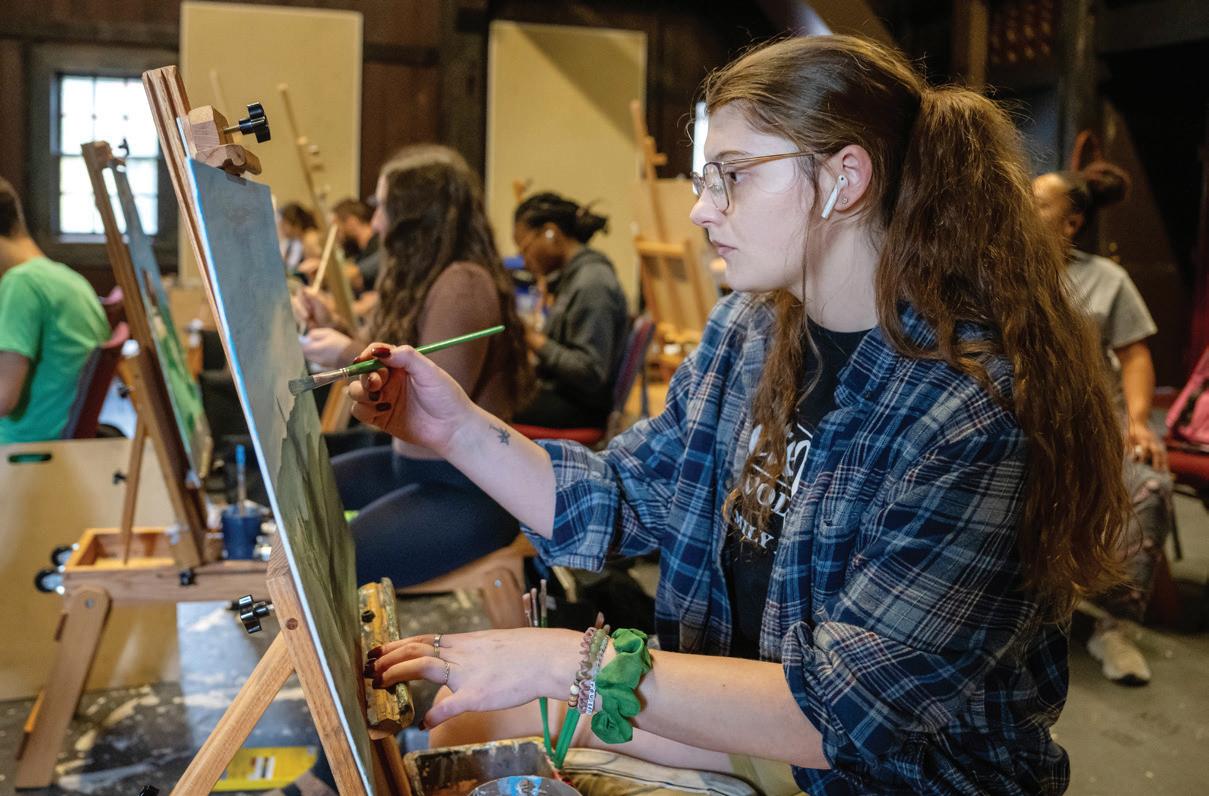
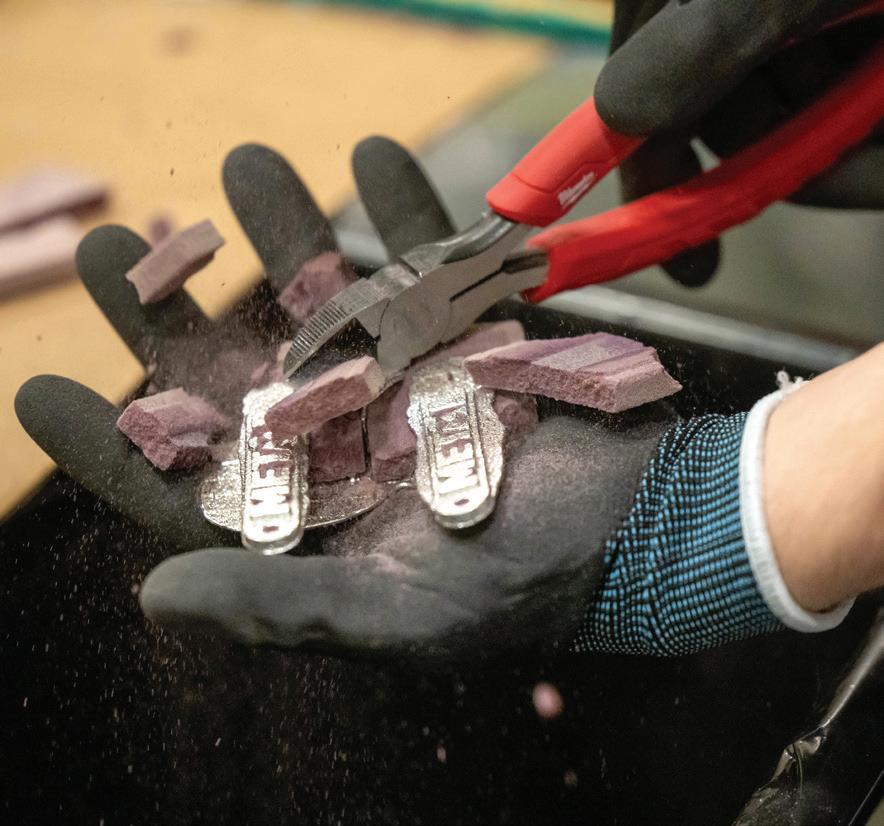

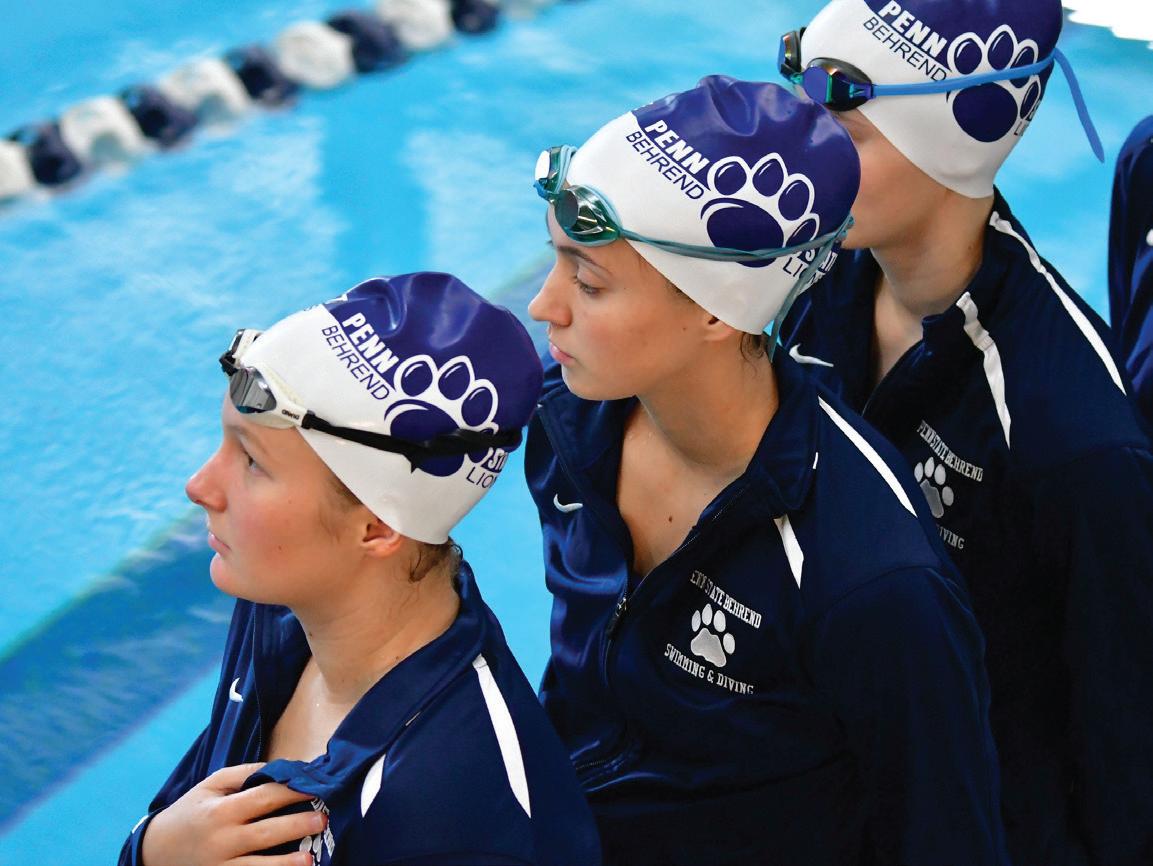
The number of first-year and transfer students at Penn State Behrend increased for a fourth consecutive year in 2024, mirroring growth in the college’s academic programs, research expenditures, and campus infrastructure.
New-student enrollment grew by 4.4 percent.
Residential enrollment increased by 1.4 percent, to 3,368 students. Online enrollment in World Campus programs taught by Behrend faculty members increased by 6.4 percent, to 1,018 students.
That growth complemented the expansion of Behrend’s research enterprise, which now includes nearly $10 million in annual expenditures. It bolstered the college’s industry and community engagement, including a planned Center for Manufacturing Competitiveness. It also demonstrated the appeal of innovative academic programs, including new majors in Polymer Engineering and Science and Interdisciplinary Science and Business.
The college also has developed a

new bachelor’s degree in Functional Data Analytics, where students build expertise in Big Data.
“We have been strategic and intentional as we develop and enhance new academic programs, expand our research and industry partnerships, and invest in
Jacob Jones, a former business consultant at Gannon University’s Small Business Development Center, was hired to lead the Black School of Business’s Center for Family Business. He will work closely with Dr. Chris Harben, the academic director of the center and the Toudy Chair of Entrepreneurship and Family Business, to develop programming and services that support the center’s members with information and expertise in succession planning, estate planning, social media, management information, and other aspects critical to the success of family-owned businesses in northwestern Pennsylvania.

campus infrastructure,” Chancellor Ralph Ford said. “At every step, we weigh the benefits to our students: We bundle the power and prestige of a Penn State degree with a close-to-home campus and a consistent commitment to providing return on investment.”
Behrend

Talks is a podcast featuring a variety of guests talking about topics key to the growth and success of the Erie region and beyond. Hosted by Chancellor Ralph Ford, the talks cover everything from managing inflation to AI and its impact on cybersecurity. Find past episodes at behrendtalks.buzzsprout.com or wherever you get your podcasts.
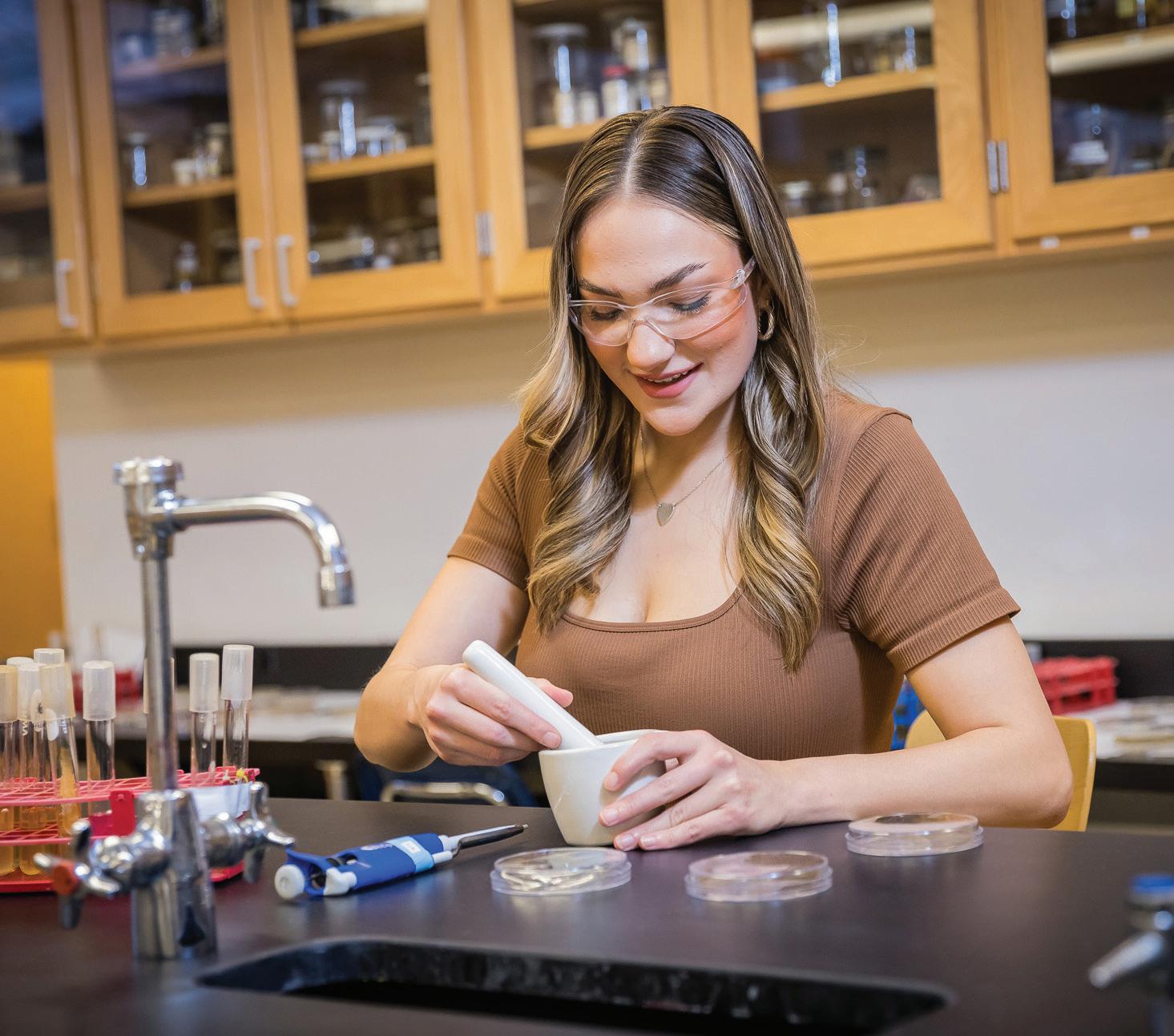
Penn State Behrend has been awarded two new Carnegie Classifications from the American Council on Education and the Carnegie Foundation for the Advancement of Teaching. The distinctions recognize the college’s research strengths and the advanced earning potential of Behrend graduates.
The new Research Colleges and Universities designation recognizes institutions with at least $2.5 million in annual research and development expenditures. Behrend generates nearly $10 million in sponsored research every year.
Just 216 institutions earned the Carnegie Classification for research in 2025. At Penn State, only Behrend and Penn State Harrisburg hold the designation.
“Research opportunities are a pillar of Penn State Behrend’s ‘Open Lab’ approach to learning,” Chancellor Ralph Ford said. “For students—particularly undergraduates—a research experience can be a differentiator. In the lab or in the field, they more fully understand the nature of their work, and they see firsthand how they can make a difference.”
The Higher Earnings designation recognizes institutions whose graduates earn highly competitive wages eight years after beginning their undergraduate experience. Just 10 percent of all U.S. colleges and universities hold the classification.

Dr. Greg Filbeck, former director of the Black School of Business, was named vice chancellor and associate dean for academic affairs at Behrend, where he has taught since 2006. He will oversee all aspects of the college’s academic portfolio, including academic planning, assessment and evaluation; strategic planning related to academics; shared governance with the college’s faculty; and the development of new academic programs.
Dr. Ozgun Demirag, the Samuel A. and Elizabeth B. Breene Professor of Operations and Supply Chain Management, is the new director of the Black School of Business. She had served as interim director since July 2023. She holds a Ph.D. in industrial and systems engineering from Georgia Institute of Technology and has previous teaching and research experience at the Chinese University of Hong Kong and at Norfolk Southern Inc.
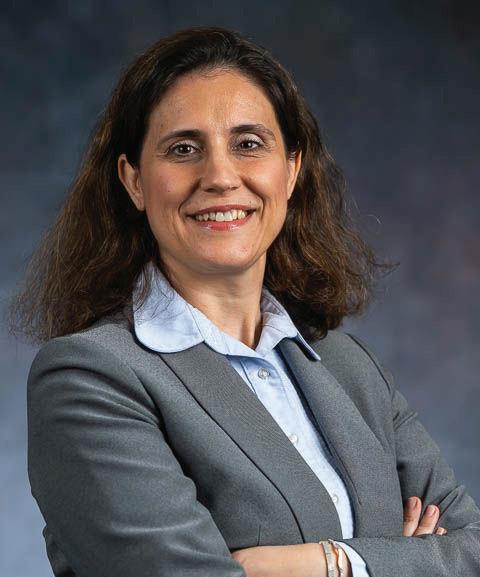
Dr. Cora E. MacBeth ’96, a chemist with twenty years of experience as a faculty member, researcher, and academic administrator at Emory University, has been appointed director of the School of Science. She earned a bachelor’s degree in chemistry at Behrend in 1996 and holds a doctorate in chemistry from the University of Kansas. Prior to returning to Behrend, she served as associate dean of the Office for Undergraduate Education in the Emory College of Arts and Sciences.


Penn State Behrend hosted the 2024 Keystone Digital Humanities conference, an annual gathering of institutions and practitioners that promote collaborative scholarship in digital humanities research and pedagogy. The event, which was spearheaded by faculty members in the Digital Media, Arts, and Technology program, brought seventyfive researchers to Behrend for three days of digital play. They experimented with and explored interactive storytelling, generative AI, gaming culture in Iran, and historic textual descriptions of art, among other topics.
A new partnership with the India-based Gandhi Institute of Technology and Management (GITAM) is creating teaching and research opportunities at Penn State Behrend—including “2+2 programs” that enable students at GITAM to complete their undergraduate degrees at Behrend.
Each of Behrend’s four academic schools is developing curricular pathways that can support students from India. The effort supports an Association of American Universities (AAU) task force that is promoting collaboration between U.S. and Indian universities.
Penn State President Neeli Bendapudi is one of five co-chairs of the AAU task force.
“The benefit, for our students, is really in terms of global enrichment,” said Dr. Greg Filbeck, vice chancellor and associate dean for academic affairs at Behrend. “It’s the ability to travel, to study abroad, and also to benefit their curriculum and their experiences, as they go out to work in what we know is a global economy.”
A new book by Dr. Joseph M. Beilein Jr., professor of history, chronicles the dramatic transformation of Penn State Behrend from 1980 to 2010.

The book, Vision & Resilience, charts the growth of the college under the leadership of former administrators John Lilley and Jack Burke, who defied national trends in higher education and established Behrend as a thriving hub of research and learning in northwestern Pennsylvania.
Facing tensions on campus and broader economic challenges, Lilley and Burke forged partnerships with faculty, students, and the Erie community to boost enrollment, expand facilities, and position Behrend as a destination campus.
“Without John Lilley and the work he did with Jack Burke, Behrend would not be what it is today,” Beilein said. “This really was a watershed moment for the college.”
The book, published by Penn State University Press, is available at psupress. org and at Amazon. To learn more, check out Chancellor Ralph Ford’s “Behrend Talks” podcast, which featured an episode about the book. You can listen at behrendtalks. buzzsprout.com.

A$6.5 million state grant has positioned Penn State Behrend to begin construction of the Center for Manufacturing Competitiveness, an industry-facing research facility and the centerpiece of the college’s Project RESOLVE.
The grant was awarded through the Redevelopment Assistance Capital Program (RACP), with support from the region’s legislators, including State Sen. Dan Laughlin and State Rep. Robert Merski. RACP grants advance regional projects that are likely to increase employment, tax revenues, and other measures of economic activity.
The new grant builds on an array of federal, state, local, and University support for the Center for Manufacturing Competitiveness, including:
• $3 million from Penn State
• $2.5 million in federal funding, secured by U.S. Sen. John Fetterman
• $2.5 million in American Rescue Plan funding, provided by Erie County
• $2.5 million in Erie County Gaming Revenue Authority funding, awarded by Erie County
• $1.5 million in RACP funding, awarded in 2023
“Project RESOLVE is an ambitious, long-range initiative that will frame the next generation of manufacturing in the Erie region and beyond,” Chancellor
Ralph Ford said. “We are grateful to Gov. Shapiro, Sen. Laughlin, Rep. Merski, Erie County Executive Brenton Davis, and the many other county and local leaders who see the potential in RESOLVE and the Center for Manufacturing Competitiveness and continue to support it.”
With the new funding in place, Penn State Behrend can finalize architectural plans and begin construction of the Center for Manufacturing Competitiveness, which will include plastics and metal-casting labs. The center, which will be built in Knowledge Park, will also house the nation’s first heavy-haul battery testing facility, where researchers and industry partners will work to improve the safety and efficiency of battery packs for the rail, marine, and mining industries.
“With our history of university-industry engagement and the market strength of Erie-based transportation, plastics, and metal-casting companies, we are uniquely positioned to advance the adoption of new technology and equip the region’s workforce with the skills to use it,” said Dr. Amy Bridger, assistant dean for innovation and corporate strategy at the college. “With the support of multiple partners, including the state lawmakers who endorsed and advocated for our RACP application, we are now able to move forward.”
The Center for Manufacturing Competitiveness is a focal point of Project RESOLVE, a ten-year regional effort to shift the region’s manufacturing companies to a circular economic model. The center will support companies as they invest in their operations and transition to sustainable technologies that will ultimately reduce pollution in and near the region’s freshwater resources, including Lake Erie.
Workforce training in the metal-casting sector has already begun. Those programs, funded through a $4.4 million grant from the Institute for Advanced Composites Manufacturing Innovation, complement the college’s longstanding plastics-training initiatives.
“By including voices from industry and all levels of government in the planning and design of the Center for Manufacturing Competitiveness, we have created a relevant model of industry engagement that has been broadly and enthusiastically supported across a diverse set of stakeholders,” Bridger said. “Ultimately, the measure of success is the increased investment by manufacturers in their facilities and employees—an investment that will make their businesses more competitive, generating economic impact across the region—and the opportunities that it creates for our students, many of whom go on to work in these industries.”

New giving by Dave Meehl, a retired financial officer who worked at accounting firms, food companies, and Lakeshore Community Services, will provide $5 million to Penn State Behrend’s schools of engineering and science.
A $3 million gift established Behrend’s first named school directorship: the James R. Meehl Director of the School of Engineering. The gift is named for Meehl’s late father, who worked at and later owned Eureka Electrical Products, the oldest continuously operated company in Erie County.
An additional $2 million estate commitment will provide ongoing support for Behrend’s School of Engineering and School of Science.
“We appreciate the vision and commitment that shaped these gifts,” Chancellor Ralph Ford said. “The support of the Meehl family has accelerated the growth of Penn State Behrend in recent years. Our students and faculty have directly benefited from Dave’s vision and his intentional support of an array of programs at the college, including the School of Engineering, the School of Science, and Behrend athletics.”
The new Meehl directorship, in particular, elevates both the School of Engineering and its leadership. “It positions us to do even more with the academic and research programs that already distinguish Penn State
Behrend as a leader in engineering and innovation,” Ford said.
Funding will be used to purchase equipment and expand research and teaching labs in Burke Center and the Advanced Manufacturing and Innovation Center.
“This funding will help us recruit and retain high-performing faculty members and support them in the early years of their careers as they develop their preliminary research and begin to bring in external research funding,” said Dr. Tim Kurzweg, the director of the School of Engineering. He is the first to hold the Meehl directorship title.
The directorship continues a pattern of giving at Behrend that honors James Meehl. In 2023, Dave Meehl created the endowment that expanded and named the James R. Meehl Innovation Commons, a product design and prototyping lab that anchors both the Invent Penn State network and the Northwest Pennsylvania Innovation Beehive Network.
The estate commitment to the School of Science is, in part, a tribute to Dave Meehl’s son Aaron, who earned a degree in biology at Behrend in 2012.
“THE SUPPORT OF THE MEEHL FAMILY HAS ACCELERATED THE GROWTH OF PENN STATE BEHREND IN RECENT YEARS. OUR STUDENTS AND FACULTY HAVE DIRECTLY BENEFITED FROM DAVE’S VISION AND HIS INTENTIONAL SUPPORT OF AN ARRAY OF PROGRAMS AT THE COLLEGE, INCLUDING THE SCHOOL OF ENGINEERING, THE SCHOOL OF SCIENCE, AND BEHREND ATHLETICS.”
— CHANCELLOR RALPH FORD
“The Meehl family has always believed that education is the best way to increase the quality of life for individuals and society,” Dave Meehl said. “We greatly appreciate that Penn State Behrend has allowed us the opportunity to improve teaching and research in the School of Engineering with this gift.”

On his birthday, Ernst Behrend liked to swim a mile in the Glenhill Farm pool.
That was eighty laps. Outdoors. In March.
After his death, when the farm became Behrend Center, and then Penn State Behrend, the pool remained a central feature of the property. A generation of faculty and staff children learned to swim there.
“We grew up in that pool,” said Jeff Kochel, whose father, Irvin Kochel, ran the college from 1954 until 1980. “Our mother would take us early in the morning, and we’d stay all day.”
Last summer, with funding from Jeff Kochel and his wife, Pam, and with additional support from the Student Facility Fee, the University Access Committee, and campus beautification funds, the college reconfigured the original Glenhill pool site, creating a community-focused greenspace in the historic core of the Behrend campus.
The pool was filled in. Its surface was turfed, preserving the original outline of the water. The pool deck was expanded, making room for some modern-day features: charging stations, Wi-Fi, and bollard lighting.
At the south end of the pool, a fountain leads to granite steps that connect to the walkway between Senat Hall and the School of Science complex—an area where the Behrends once maintained an orchard.
“When the Behrends lived here, the pool was a focal point of the property,” said Ken Miller, the former senior director of administration and student affairs. “They entertained here. They hosted parties on the pool deck, with a big tent-like structure set up to provide shade.”
In the early years of the college, the pool was used in another way: It served as an emergency fire reservoir.
The pool was closed in the early 1990s. The college’s maintenance staff cleaned and filled it at the start of every summer, but swimming no longer was permitted. Eventually, the pool was covered with a tarp.
The renovated space, now called Glenhill Gardens, was designed to honor the history of the pool while creating a new, parklike setting where students and other members of the campus community can gather.
“Part of the inspiration for this came from how students use the Mary Behrend Monument,” Miller said. “There has been a need for more outdoor programming space—places where students can gather for events, or just sit and relax between classes, taking in the beauty of the campus—and this provides that.”

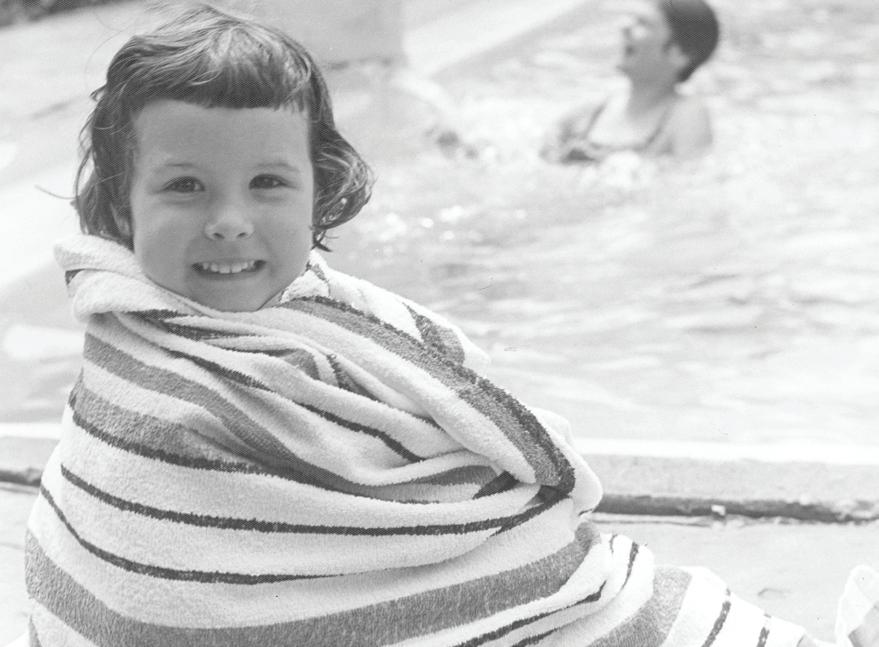


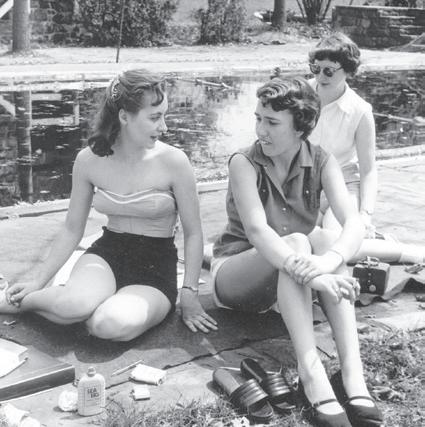


The space that served as Mary Behrend’s art studio is a center of art instruction once again.
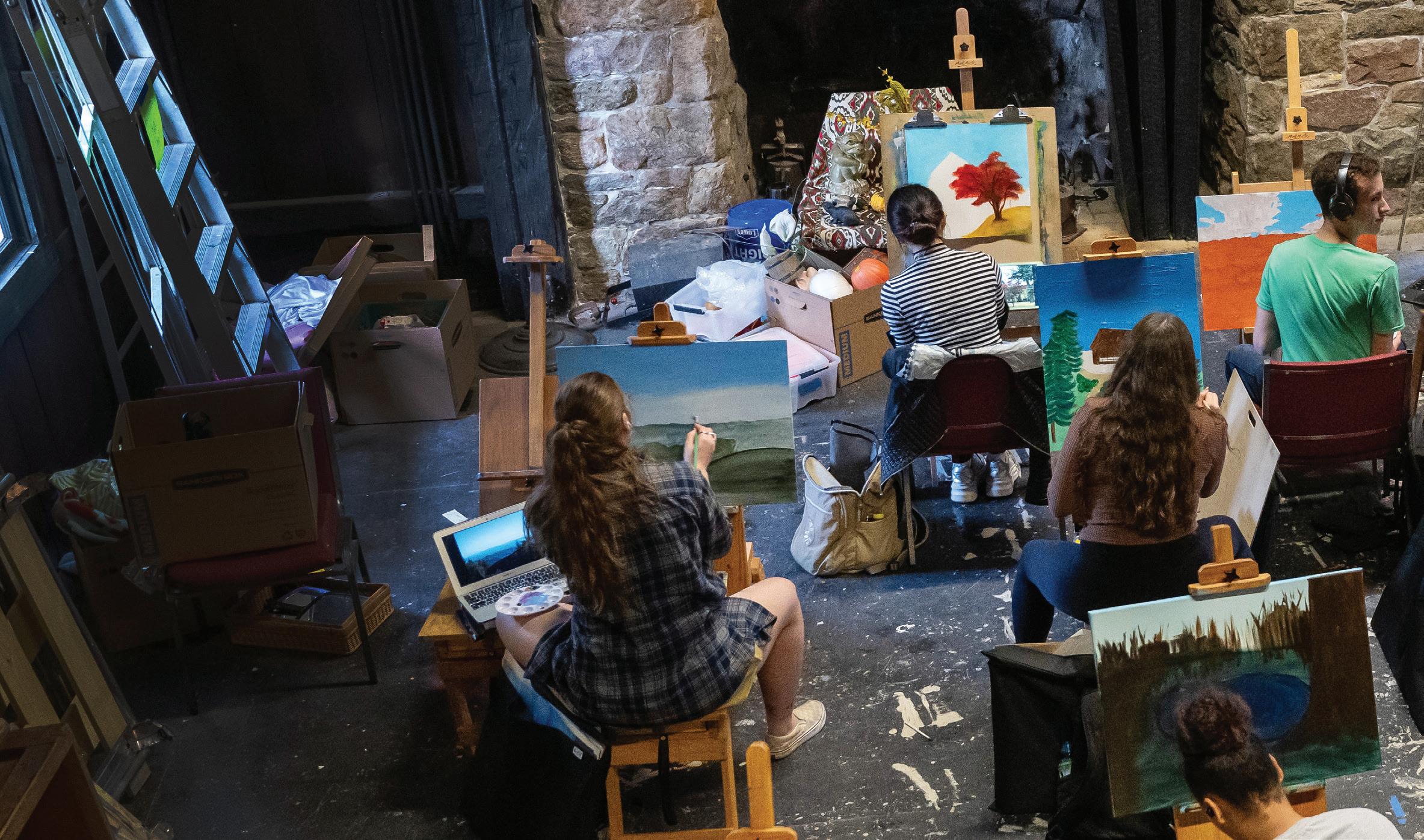
The “small barn” located in front of the Glenhill Farmhouse at Penn State Behrend has been many things: a bunkhouse, a farmer’s office, a student lounge, a library, a classroom, and a theater. The building was part of the original estate that Ernst and Mary Behrend purchased for their country getaway.
The Behrends turned the barn into a cottage, adding a stone foundation, a large fireplace and chimney, a transom, windows, a staircase, a bathroom, and a “sleeping bunk” that provided guest lodging in the 1930s. Mary occasionally used the space to entertain her friends.


In later years, before Mary donated the property in 1948, creating what is today Penn State Behrend, the little cottage became Mary’s art studio, a cherished, quiet place for her to paint. She mostly painted landscapes, often scenes from her Glenhill farm.
Mary took her hobby seriously. She learned from one of the best: Famed Erie artist Joseph Plavcan was her painting tutor. The two worked together at Mary’s studio, where, in 1945, Plavcan left a sketch of Mrs. Behrend in a guestbook (above).
It’s a scene that could be recreated today, eighty years later, with one of the dozens of Behrend students who are, once again, painting and drawing in Mary’s studio.
When Dan Schank, associate teaching professor of art, learned his art classes would be moving to the studio, he was excited. The studio offered more space, which meant more students could take an art elective. It’s also a more inspiring place to be creative.
“It’s such a great building with its deep, dark wood structure and stone accents,” Schank said. “It has a long, rich history, and I think students benefit from making art in a place with such an eclectic flavor.”
There is no mistaking the purpose of the studio today.
Brushes fill buckets in the back of the room. Tubes of paint and cans of fixer clutter a portable cart. Canvases are propped against the old wooden walls to dry while watercolor paintings are laid flat in a wire rack in the entryway.
Students fill the art stools spread out on the paint-splattered floor, their work in various stages of completion in front of them. Schank wanders among them, fielding questions and offering observations, suggestions, and compliments.
While Behrend is largely known for its strong STEM presence, Schank says there’s great value in including the arts and humanities as well.
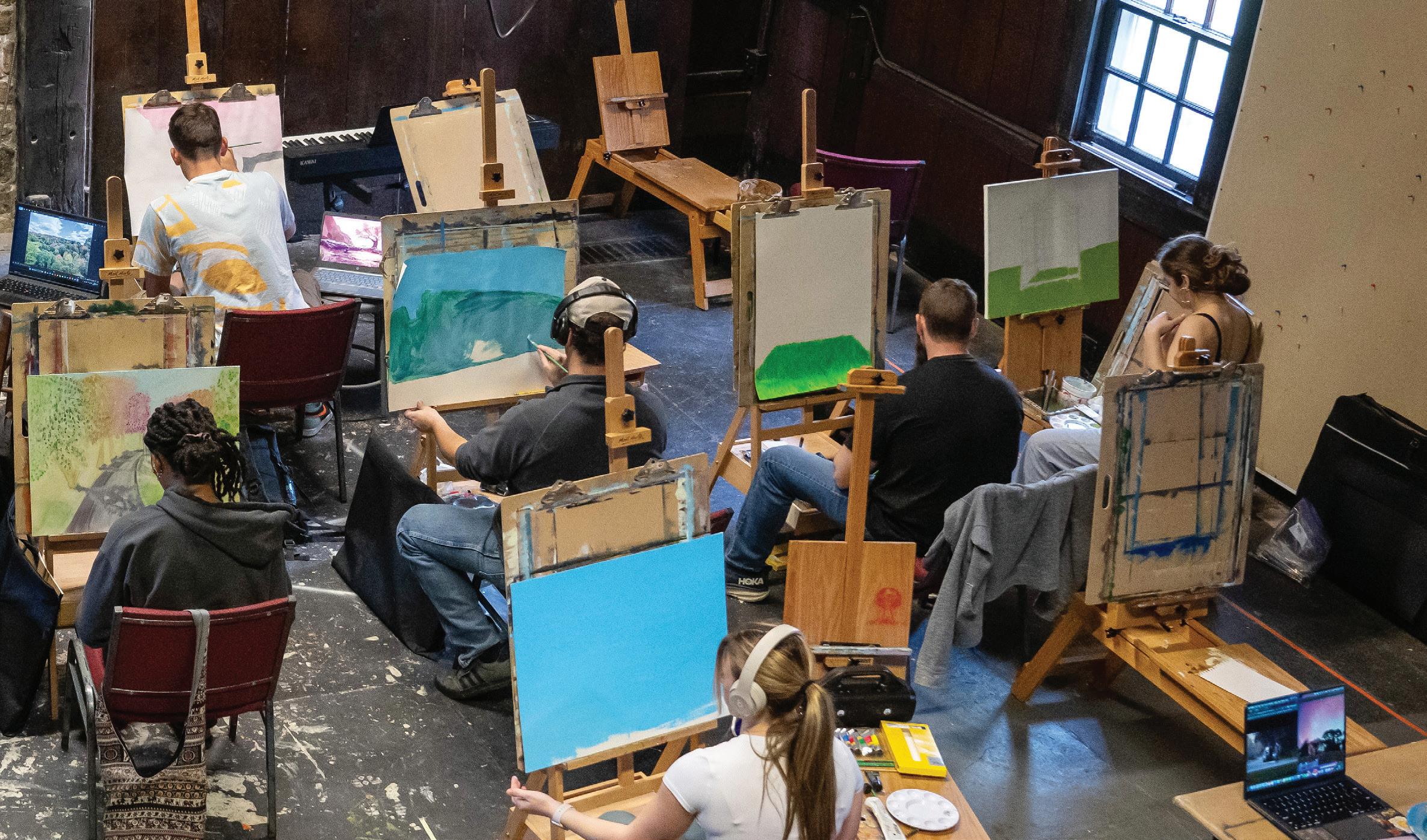
“Courses like Intro to Painting or Intro to Drawing encourage students to use a different mental skill set than many of them are used to,” he said. “I teach them to rely on intuition, something that contrasts sharply with the part of their brain that is constantly fact-checking or measuring. There are no right answers here, and by working more instinctively, they develop a new way to observe the world.”
Schank has noticed clear connections to many disciplines at Behrend that may not be thought of as creative in a traditional sense.
“A lot of our engineering majors are natural ‘tinkerers,’” he said. “They like pulling things apart, seeing how they work, and putting them back together again. There’s a trial-and-error quality to artmaking that utilizes this instinct very effectively and allows them to do so in a safe, low-risk setting. They can take big creative swings without having to get it perfectly right.”
Schank, who has been teaching art for decades, equates artistic talent to athletic achievements.
“A lot of art instruction, especially at the introductory level, is like learning a sport,” he said. “Some people are naturally stronger or faster than others, but everyone can improve with enough practice.”
When students struggle in an art class, Schank said, they tend to take it more personally than if they’d done poorly on a science or English exam.
“But I don’t think the processes are all that different,” he said. “If you put the time in, you can achieve the end goal that you desire. You just have to keep working on it.”
There’s no doubt Mary Behrend and Joseph Plavcan, the Behrend art studio’s original student and teacher, would agree. They spent many hours putting paint on canvas in the very space Behrend students are learning in again today.
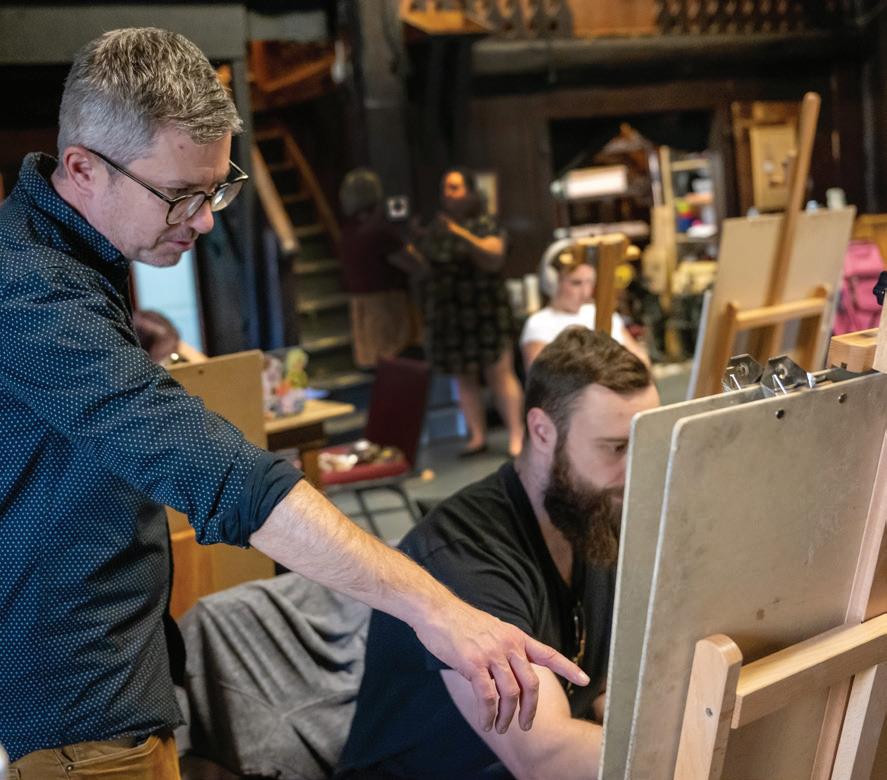
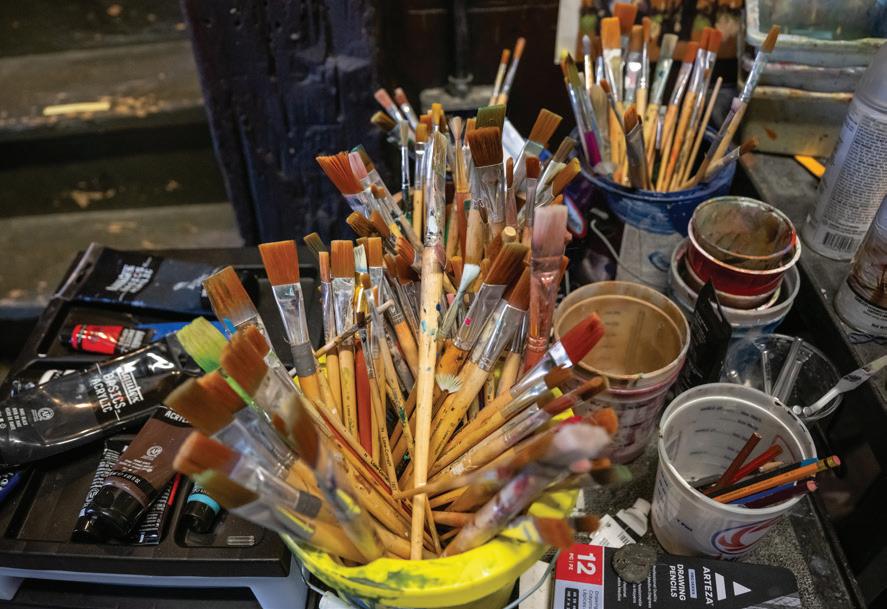
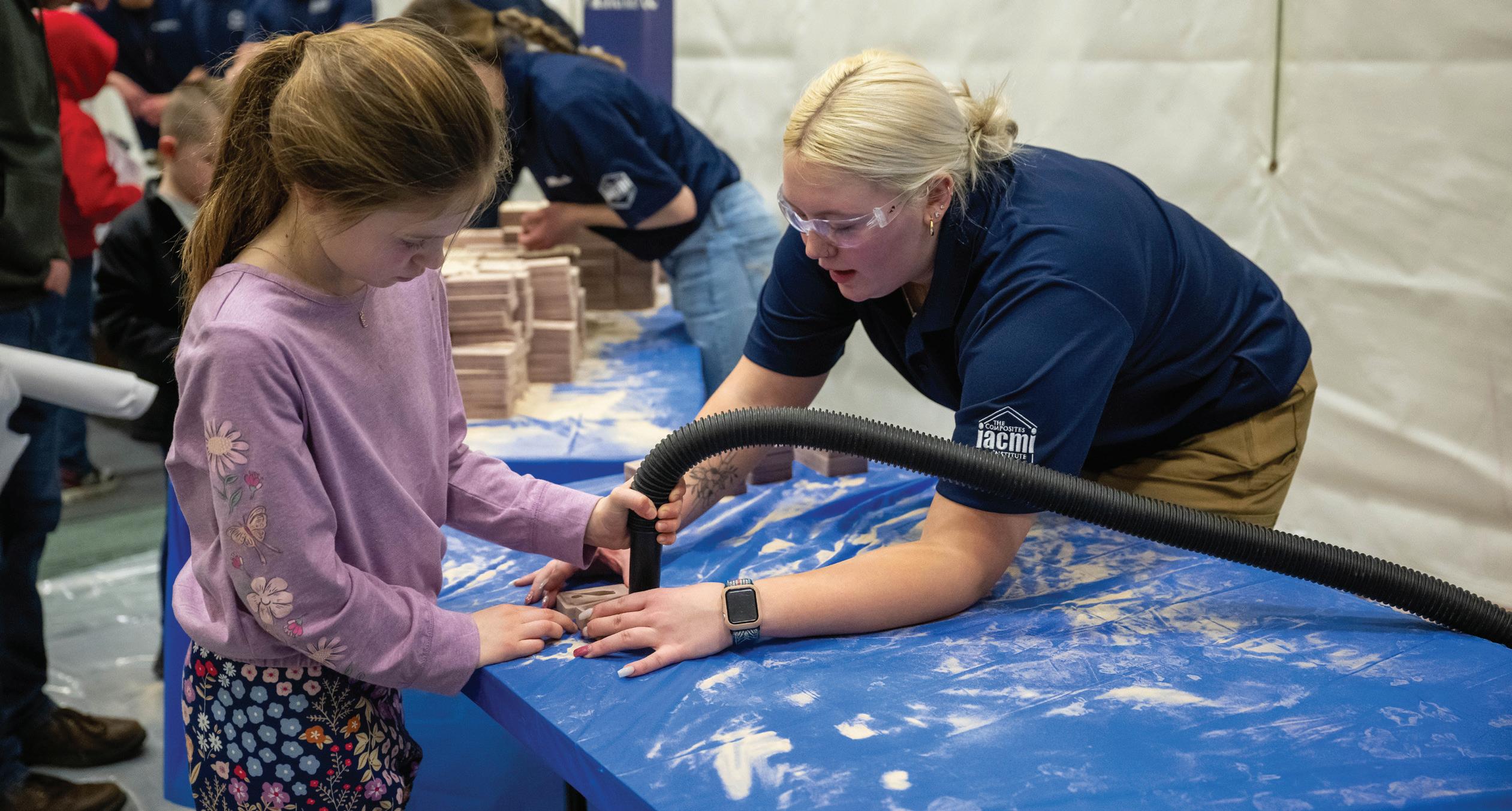
The Institute for Advanced Composites Manufacturing Innovation (IACMI) and the Department of Defense are investing $4.4 million in metals-based workforce development programs at Penn State’s Behrend and University Park campuses.
The three-year initiative— the Metallurgical Engineering Trades Apprenticeship and Learning program, or METAL—is an effort to address a shortage of skilled labor in the manufacturing sector. Nearly one-fourth of the manufacturing workforce is aged 55 years or older, according to the U.S. Census Bureau. By 2030, more than two million manufacturing jobs will be unfilled, according to the Manufacturing Institute.
of Defense, which relies heavily on cast and forged equipment.
The department has identified a need for at least 122,000 mission-critical manufacturing personnel by 2028.
“The foundational building blocks for all manufacturing start with metal,” said Joannie Harmon, vice president of workforce development at IACMI.
“THE FOUNDATIONAL BUILDING BLOCKS FOR ALL MANUFACTURING START WITH METAL.”
JOANNE HARMON, VICE PRESIDENT OF WORKFORCE DEVELOPMENT AT IACMI
“Fostering development of an industrial-base workforce and ensuring the right skill sets are available—from skilled trades on the shop floor through doctoral-level engineering capabilities in a research setting—is vital to national security.”
That lack of skilled workers is a concern for the Department
Dr. Paul C. Lynch, associate professor of industrial engineering, leads the METAL program at Penn State. As a member of the project’s steering committee, he works with University colleagues to
develop metals-focused manufacturing teaching programs, including:
Workshops and outreach events for K-12 students
Hands-on manufacturing “boot camps” for students 18 and older
Certificate and apprenticeship programs
An online curriculum in metal manufacturing
Dr. Mark Rubeo, an assistant professor of mechanical engineering at Behrend, is assisting with the metals-manufacturing teaching programs. He also is providing guidance on postprocessing techniques for castings and forgings and their effects on material microstructures and mechanical properties.
Two faculty members in the College of Engineering at University Park also are contributing to the effort. They are assisting with the teaching programs, with an emphasis on apprenticeship and potential certificate programs, and are developing digital manufacturing modules, including 3D sand-printing and AR/VR learning programs.
Researchers at the University of Tennessee are working collaboratively with the Penn State team, providing additional support. Jobs for the Future, a national nonprofit organization dedicated to creating career pathways for low-wage workers, is helping to develop the apprenticeship programs.
The METAL program directly supports Behrend’s Project RESOLVE, a ten-year regional effort to shift the metal manufacturing, plastics, and transportation industries to a circular economic model that reduces pollution in and near the region’s freshwater resources, including Lake Erie. A planned Center for Manufacturing Competitiveness will include labs for metal casting and additive manufacturing—an innovation “sandbox” where University researchers and industry partners can test new techniques.
“We want to inspire the next generation to pursue careers in metal manufacturing,” Lynch said. “The ultimate goal is to position the Pennsylvania metals industry to be competitive in both the national and international marketplaces, and to keep family-sustaining jobs in the United States, including here in the Erie region.”

Each year, the Steel Founders’ Society of America (SFSA) challenges university students across the country to combine engineering skill with creative design in its annual Cast in Steel competition. Using modern casting techniques, student teams are tasked with recreating a historic or functional steel object.
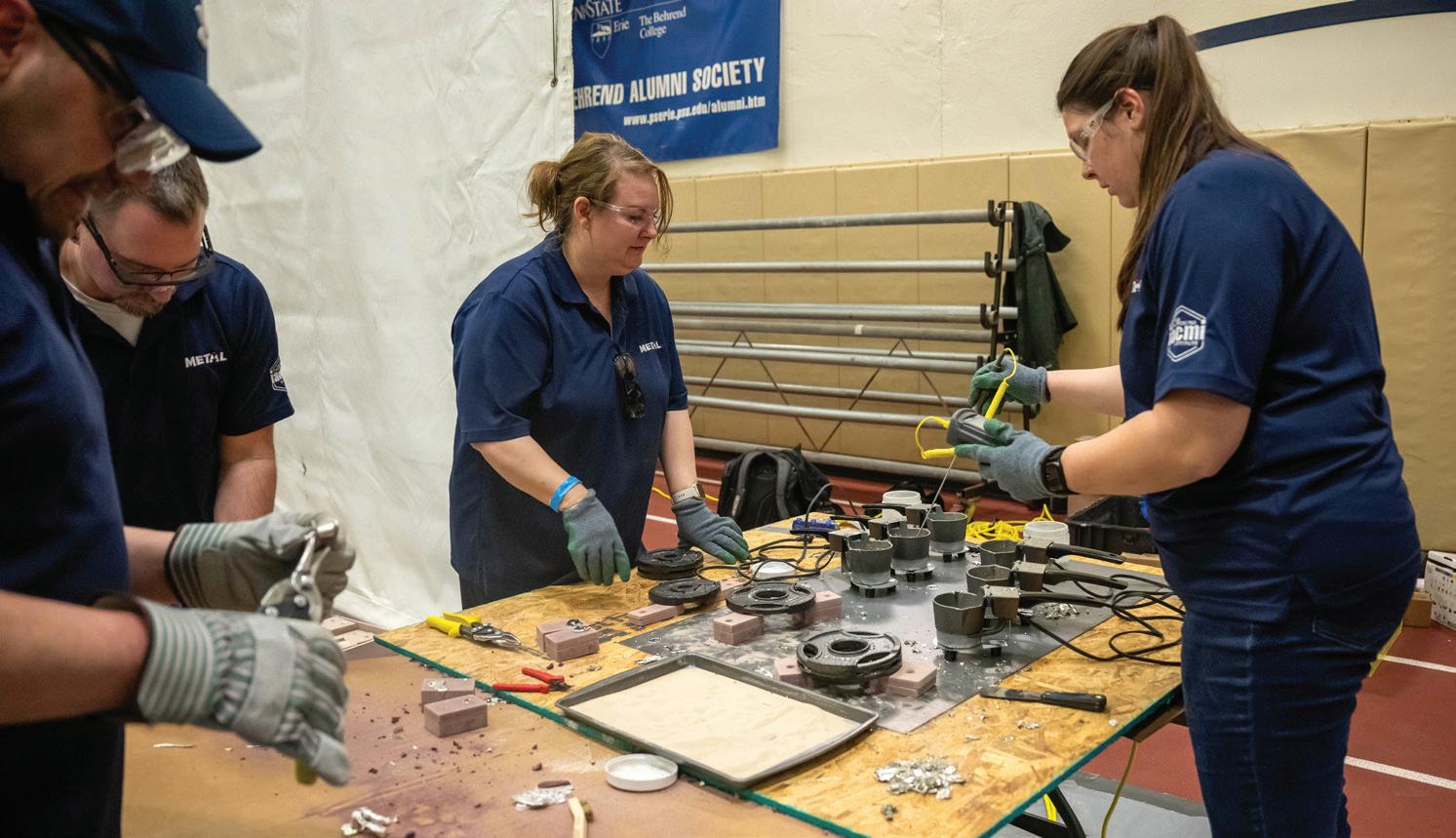
This year, participants were asked to produce a fully functional replica of one of George Washington’s swords. The finished weapon had to be no more than 43 inches long and weigh less than 4.4 pounds.
Penn State Behrend’s Cast in Steel team shared the journey with a crew from Workaholic Productions, a documentary team that has partnered with National Geographic, the History Channel, and PBS. The crew followed the process of designing and casting the sword and traveled with the team to Atlanta for the national event.




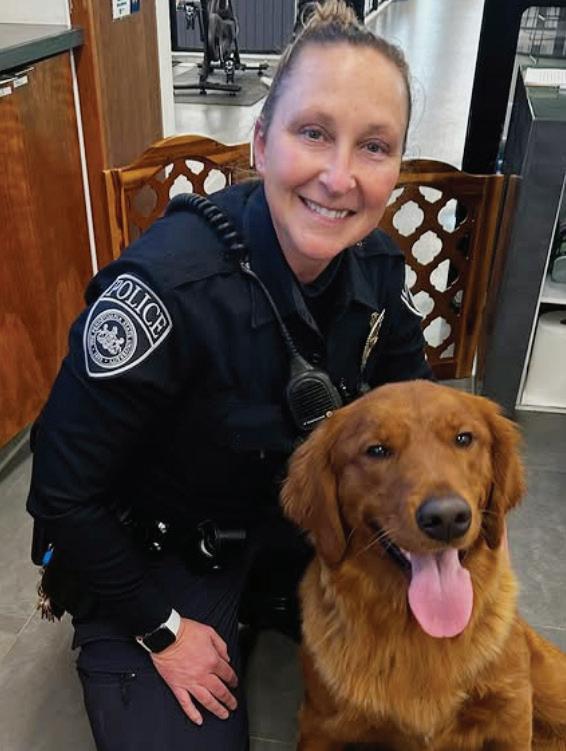
If you visit Erie Hall on a weekday, it’s not unusual to find a group of students gathered around the front desk. They’re not looking for information or equipment, but rather the chance to say hello to Behrend’s emotional support specialist, Millie, a one-yearold golden retriever who enjoys endless attention from students, staff, and faculty.
“Millie loves her job,” said Kelly Wilson, the campus recreation manager and Millie’s “mom,” who brings Millie to work with her every day. “The worst days for Millie are Saturday and Sunday. I thought she’d like to relax on weekends, but she just wants to go to work. She lives for Mondays.”
Millie’s role at Behrend was serendipitous. Last summer, on the day Wilson decided she was going to get a golden retriever puppy, she ran into Melissa Sulkowski, director of the Counseling Center. Wilson mentioned her plans, and Sulkowski told her that she was in the middle of submitting paperwork to request an emotional support dog for Erie Hall.
“Millie’s future was determined that day, before I had even picked her up,” Wilson said.
And she was the perfect choice. Millie excels at offering exactly what her visitors need: a quick hello before heading to the gym, a walk in the fresh air (students can “check” her out for walks), or even a shoulder to cry on.
“One day, a student who regularly checks Millie out for walks came back without her,” Wilson said. “They were walking around when they saw another student sitting on a bench who was upset and in tears. Millie immediately pulled toward this student, sat down, and refused to leave her side.”
Wilson said they stayed on the bench until the student was ready to face the day.
Emotional support animals have become invaluable on college campuses, offering relief from homesickness, stress, and loneliness.
“Millie brings a lot of joy and peace to students— many of whom miss their own pets,” Wilson said. “When we walk around campus, nearly every student greets her, whether by name or with a smile. It’s hard to stay in a bad mood around Millie.” Millie’s talents go beyond offering comfort. She’s also been an educational aid.
“We have a nursing student who has taken Millie to biology lectures, tabling events, and class,” Wilson said. “But my favorite interaction between her and Millie was when the student was practicing for her Licensed Practical Nurse exam. She would be tested on meeting with a patient from start to finish, so she used Millie as her patient. It was amazing to see how relaxed she became while working through her script with Millie.”
Though Millie doesn’t get a paycheck, she certainly gets benefits. She loves Fresh Fruit Fridays at Erie Hall, when she gets her weekly banana. But, as Wilson said, her preferred currency is attention.
“If you’re sitting and petting her, and you stop, she’ll nudge you to keep going,” Wilson said. “She loves being the center of attention.”
While there will be fewer students with her this summer, Millie won’t be bored. She’ll be taking classes to become a certified therapy dog.
Not all dogs make the cut, but with her year of experience supporting the Behrend community, we’re confident that Millie will be golden.
It began, as all good stories do, with a blank page, and a question: Could Penn State Behrend, a college known for its STEM programs, become a launchpad for literary careers?
In 2004, a group of faculty members and administrators believed the answer was yes. That fall, they launched the college’s Bachelor of Fine Arts in Creative Writing, making Behrend the only Penn State campus to offer the degree.
Now, more than twenty years later, the program, still the only one at Penn State, continues to turn blank pages into books—and students into authors.
Every student who graduates from Behrend’s Creative Writing program writes a book as their senior thesis. The books are bound and shelved at Lilley Library. But Dr. Tom Noyes, professor of English and creative writing, said the true measure of success is not just the physical manifestation of a volume of written work, but whether the author has a unique style.
“There is a lot of modeling as a young
writer,” Noyes said. “They emulate the authors that they read and respect. But, by the time they graduate, we want them to have developed their own individual vision and voice, and the confidence to use it.”
They accomplish this the only way any writer ever does—putting a lot of words on paper.

“You have to be willing to write badly to write well,” Noyes said. “It’s a process.”
Reading, critiquing, and evaluating one another’s work is another important part of that process.
Behrend students have the chance to take this to a higher level by helping curate content for Lake Effect, the college’s international literary journal, which features works of fiction, creative nonfiction, and poetry by established and emerging writers.
As part of a class, students and faculty members read submissions and rate how well they might fit in the journal. That often leads to discussions about the structure and voice in individual pieces and the overall
Behrend’s Bachelor of Fine Arts in Creative Writing program began in the fall of 2004. It was developed by George Looney, Distinguished Professor of Creative Writing and English; Dr. Jack Burke, former chancellor; and Dr. Archie K. Loss, professor emeritus of English and American studies and former director of the School of Humanities and Social Sciences.
effectiveness of the writing.
The journal is published by the School of Humanities and Social Sciences and is supported by an endowment created by the family of Helen Thomas Kennedy. George Looney, Distinguished Professor of Creative Writing and English, and Aimee Pogson, an associate teaching professor of creative writing and English, serve as the journal’s editors. A new edition is published every spring. This year’s edition marks the twenty-ninth volume.
While many Creative Writing alumni have gone on to be novelists, poets, screenwriters, teachers, journalists, and editors, others are working in less-traditional places, such as law offices, environmental agencies, historical societies and museums, and in the gaming industry.
“We’ve had some Creative Writing majors get a minor in Game Development because they want to write narratives for video games,” Noyes said.
While the tools may change and the job titles may evolve, Behrend’s Creative Writing program remains grounded in the same simple but radical idea: Stories matter.

Britt Daehnke
BRITT DAEHNKE has been named director of development and alumni relations. She holds a bachelor’s degree in English communications and a master’s degree in public administration, both from Gannon University. She has spent her career in higher education— with twenty-three years of experience in fundraising, including the last six years as associate director of development and alumni relations at Behrend.

KRISTEN COMSTOCK, a 2006 Behrend Communication graduate, is the new associate director of development and alumni relations. She previously served as the assistant director of alumni
relations at Behrend, serving more than 50,000 Behrend alumni since she started in 2008.

is Behrend’s new director of alumni relations. A graduate of Clarion University of Pennsylvania with a bachelor’s degree in liberal arts, she had held a variety of roles in development and alumni relations at Clarion University, Penn State Greater Allegheny, and, most recently, Oakland Catholic High School in Pittsburgh. Her strong background in alumni engagement, enthusiasm for building relationships, and passion for affinity groups make her a perfect fit for Behrend.
A $565,000 gift from Penn State alumni William and Wendy Korb will create a permanent fund for research and innovative teaching in Penn State Behrend’s School of Engineering. The funding will be used to develop new teaching approaches and to support research initiatives and professional development opportunities for faculty and students.
The gift also will fund improvements to the school’s research and teaching labs.
“The breadth of this gift, which expands the Korb family’s generous and consistent support of the School of Engineering, will benefit students in two major ways,” Chancellor Ralph Ford said. “It will provide immediate improvements to our facilities and equipment, enhancing the undergraduate research experiences that help our graduates stand out. It also will allow us to recruit

and retain the highly engaged faculty members who shape those student experiences.”
To recognize the continued support of the Korbs, Penn State Behrend has named the lobby of the Advanced Manufacturing and Innovation Center the Korb Family Atrium. The two-story space is a gateway to Behrend’s Knowledge Park, an innovation hub that is home to twenty companies and nearly 500 employees.
“We have always felt that an investment in education is one of the best investments you can make,” said William Korb, an Erie native who retired as president and CEO of Marconi Commerce Systems. The company’s portfolio included Gilbarco, the world’s leading supplier of fuel dispensers, credit card readers, and point-of-sale devices for gasoline stations.
A $2 million estate gift from Risa Glick, a 1986 graduate of Penn State Behrend, is expanding and enhancing support services for students, faculty, and staff. The funding provides direct assistance for temporary or ongoing needs through the college’s Office of Disability Services.
The gift was inspired in part by Glick’s cousin, Jonathan, who has autism. He attended youth sports camps at Behrend.
“He particularly loved basketball camp,” said Glick, who lives in the Washington, D.C. area and works as a senior proposal manager at Arcfield, a U.S. defense, space, and intelligence contractor. “Even though he would never attend Behrend as a student, the community still went above and beyond to provide the best possible experience for him. That meant a lot to our family.”
Glick enrolled at Behrend in 1982. She wrote for the student newspaper, serving as co-editor in her senior year, and planned to finish her degree at Penn State’s University Park campus. Over time, however, she chose to remain at Behrend, where she earned a degree in Communication.
“I did not want to transfer,” she said. “I loved Behrend, and I benefited from the smaller student-to-faculty ratio.”

In the Communication program, she began a lasting friendship with Cathy Mester, a longtime faculty member in the School of Humanities and Social Sciences. Glick made an immediate gift to activate her endowment, which will be fully funded through her estate, in honor of Mester and her late husband, Richard Mester, a retired professor of logic and philosophy.
As she planned the endowment, working with members of the Development team and the Office of Disability Services at Behrend, Glick designed the gift to have broad impact, and to grow as others contribute to it.
“I wanted to create a resource that includes students, but also faculty and staff, who are key contributors to Behrend being such a wonderful school to attend,” she said. “My goal is to help provide support services for any special need on campus.”
The endowment will fund the purchase of various support tools, including Livescribe pens, which assist students, faculty, and staff with notetaking, and an electric wheelchair that can be loaned to students and campus visitors, including those attending admissions Open House events. It will expand Braille signage on the Behrend campus and provide special video monitors that will make the college’s testing center more accessible to students with limited vision.
Funding also will be used to provide inclusivity training for faculty, staff, and student tutors who work with students with neurodiverse backgrounds.
⊲ To support the Risa Glick Endowment for Disability Services, visit raise.psu.edu/GlickEndowment.
PRISCILLA HAMILTON, a Penn State Alumni Fellow and a member of Penn State Behrend’s Council of Fellows, received the Charles Lupton Volunteer Award—one of the University’s highest honors for a volunteer. Hamilton attended Behrend for two years before graduating with a bachelor’s degree in Science at University Park in 1978. She holds a doctoral degree in dental medicine, a master’s in health care administration, and a master’s in strategic studies. While at Behrend, she helped to establish the college’s ROTC program. Hamilton is a veteran of Operation Desert Shield/Desert Storm. She went on to lead the U.S. Army’s dental care system, DENCOM, which is responsible for all Army oral health care and dental clinics around the world. Now retired, she considers herself a professional volunteer. She and her husband, Gary Rafferty, are very active in the Behrend and Erie communities.

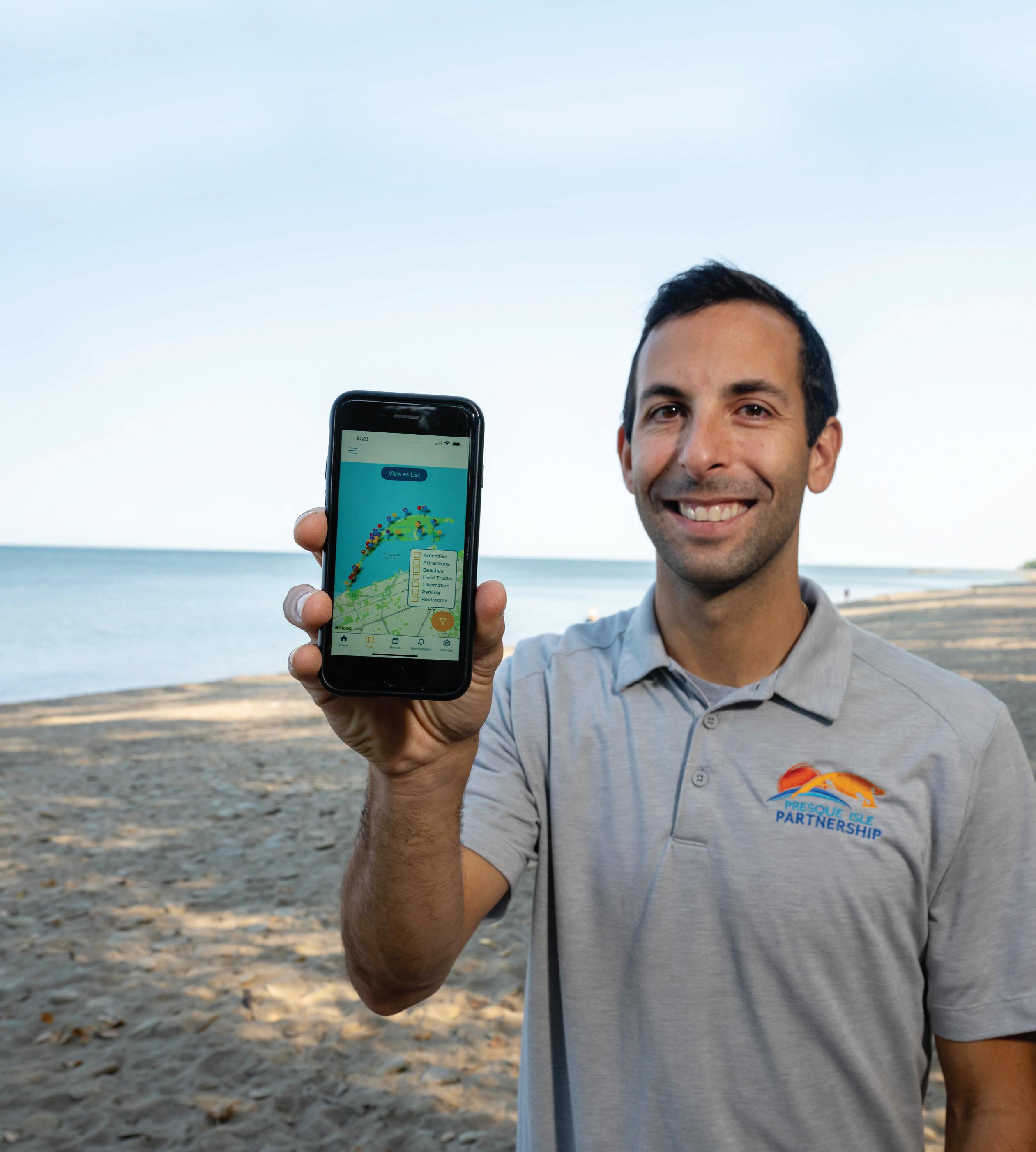
Presque Isle State Park in Erie is one of Pennsylvania’s most popular state parks, attracting 4 million visitors a year. The 3,200acre sandy peninsula stretches into Lake Erie and offers seven miles of sandy beaches, boating, fishing, hiking, bicycling, birding, and more. While it might seem hard to improve on, the Presque
Isle Partnership, an official nonprofit partner to the Department of Conservation and National Resources (DCNR) at Presque Isle, is committed to doing just that.
The partnership hosts fundraising events and generates private support for projects that enhance the park, including mobility mats and beach wheelchairs, lifeguard stations, playgrounds, and more.
The partnership receives support from the community, businesses, donors, and its large network of volunteers. In the fall of 2023, they added a new working partner: Penn State Behrend’s School of Engineering.
The organization sponsored three senior design capstone projects, challenging Behrend students to design a mobile application for the park, a lighting display, and an alternative power solution for the annual Presque Isle Lights winter event.
Jon DeMarco, executive director of the Presque Isle
Partnership, was impressed from his first meeting with the students.
“The students in each group were very thorough from the start, making sure that they understood the deliverables and the parameters they had to work within,” he said. “From a client perspective, they were on top of it. They were focused and knew what their goals were.”
When working with clients, like DeMarco, students gain not only engineering experience, but an opportunity to refine other important skills, like teamwork, communication, and time management.
“They were proactive in communicating, which was really important to me,” DeMarco said. “There was never a time when I had to seek an update. They kept me up to speed.”
Team members: Quincy Nguyen, Max Smith, Eric Petika, Collin Myers
The challenge: Develop a smartphone application for Presque Isle Partnership to enhance the visitor experience, provide navigation, and provide a way to send out important alerts.
The result: Students came up with an engaging cross-platform application called “MyPI.” The application includes an interactive map with filters to customize the experience, an events calendar, a food truck locator, FAQs, and the ability to get directions to a location at the park from their current location.
The sponsor’s response: “They did a really great job,” DeMarco said. “It looked great, worked well, and included everything I asked for and then some. There is a little refining that needs to take place before we launch the app, though. We decided not to rush it out, but to take our time and tweak it to perfection.”
2—LIGHTING
Team Members: Joseph Cyrilla, Cole Roberto, Conner Rossey, Mark Sedlak
The challenge: Create a large lighting display for the partnership’s annual holiday lights drive-through event. The display had to be programmable; easily assembled and taken apart; able to withstand Erie’s worst winter weather; sturdy, but lightweight; and compact for storage reasons.
The result: In the researching phase of the project, students came across a commercially available product—a programmable LED matrix that looks like a curtain of hanging lights—that fulfilled many of the project’s requirements. The team then developed a tent-frame structure and bracing system to hold the 10-foot-by-10-foot matrix that required no external tools and weighed just 3 pounds.
The sponsor’s response: “The curtain lights offered a unique visual addition to Presque Isle Lights,” DeMarco said. “We used it at the entrance to the park and had it programmed to display falling snowflakes and a trotting deer, which were absolutely fitting to the event’s overall theme of nature and the winter season.”
Team members: Dominic Yeso, Anthony Roberto, Owen Flisnik
The challenge: Design an environmentally friendly, portable power source that does not rely on gas or electricity and can be communicated with remotely for the Presque Isle Lights winter event. It needed to be selfcontained, air-tight and weather-proof, and light enough for two people to handle.
“If I placed this power station at Perry Monument, I wanted a way to check the power level and turn it off remotely, without having to drive out there at 8:00 p.m. in the middle of a snowstorm,” DeMarco said.
The result: Students started with an insulated plastic picnic cooler with a handle and wheels, which they fitted with a 12-volt rechargeable battery and solar charger, a temperature and humidity regulation system, and a remote communication system via cell phone. They were careful to build it in such a way that components can be easily replaced, if needed. The unit weighed in at just 90 pounds.
The sponsor’s response: “During Presque Isle Lights, we used the power pack to replace the combustion generator that powered two booths (where volunteers collected donations), spotlights, and a stereo system,” DeMarco said. “It eliminated the noise pollution of the combustion generator as well as the smell of gasoline fumes, which our volunteers greatly appreciated. It also packed enough punch to power the donation area for two full weekends without needing a charge. It is clean and quiet and sustainably built. I could see us using a dozen of these on the park.”
“Working with Behrend students on these projects was a really great experience,” DeMarco said. “I think they were excited to do something for Presque Isle, a peaceful place to exercise mind, body, and spirit, a place that means so much to so many people.”
Over six missions to the moon, from 1969 to 1972, Apollo astronauts collected more than 800 pounds of lUnar rock and soil. Chemical and isotopic analysis of that material showed that it was similar to the rock and soil on Earth: calcium-rich, basaltic, and dating to about sixty million years after the solar system formed.
Using that data, the planetary scientists who gathered at the Kona Conference in Hawaii in 1984 came to the consensus that the moon formed from debris after a collision on the young Earth.
But that might not be the moon’s true origin story. New research published in The Planetary Science Journal by Darren Williams, professor of astronomy and astrophysics, and Michael Zugger, a senior research engineer at Penn State’s Applied Research Lab, offers another possibility: That the moon was captured during a close encounter between a young Earth and a terrestrial binary—the moon and another rocky object.
“The Kona Conference set the narrative for forty years,” Williams said.
Questions lingered, however. For example, a moon that forms from a planetary collision, taking shape as debris clumps together in a ring, should orbit above the planet’s equator. Earth’s moon orbits in a different plane.
“The moon is more in line with the sun than it is with the Earth’s equator,” Williams said.
In the alternative binary-exchange capture theory, Earth’s gravity separated the binary, snagging one of the objects—the moon—and making it a satellite that orbits in its current plane.
There is evidence of this happening elsewhere in the solar system. Scientists believe that Triton, the largest of Neptune’s moons, was pulled into orbit from the Kuiper Belt, where one of every ten objects is thought to be a binary. Triton orbits Neptune in a retrograde orbit, moving in the opposite direction of the planet’s rotation. Its orbit is also significantly tilted, angled sixty-seven degrees from Neptune’s equator.
Williams and Zugger determined that Earth could have captured a satellite even larger than the moon—
an object the size of Mercury or Mars—but the resulting orbit might not have been stable.
The problem is that the “capture” orbit—the one the moon follows—began as an elongated ellipse, rather than a circle. Over time, influenced by extreme tides, the shape of the orbit changed.
“Today, the Earth tide is ahead of the moon,” Williams said. “High tide accelerates the orbit. It gives it a pulse, a little bit of boost. Over time, the moon drifts a bit further away.”
The effect is reversed if the moon is closer to Earth, as it would have been immediately after capture. By calculating tidal changes and the orbit’s size and shape, Williams determined that the moon’s initial elliptical orbit contracted over a timescale of thousands of years. The orbit also became more circular, rounding its path until the lunar spin locked into its orbit around the Earth, as it is today.
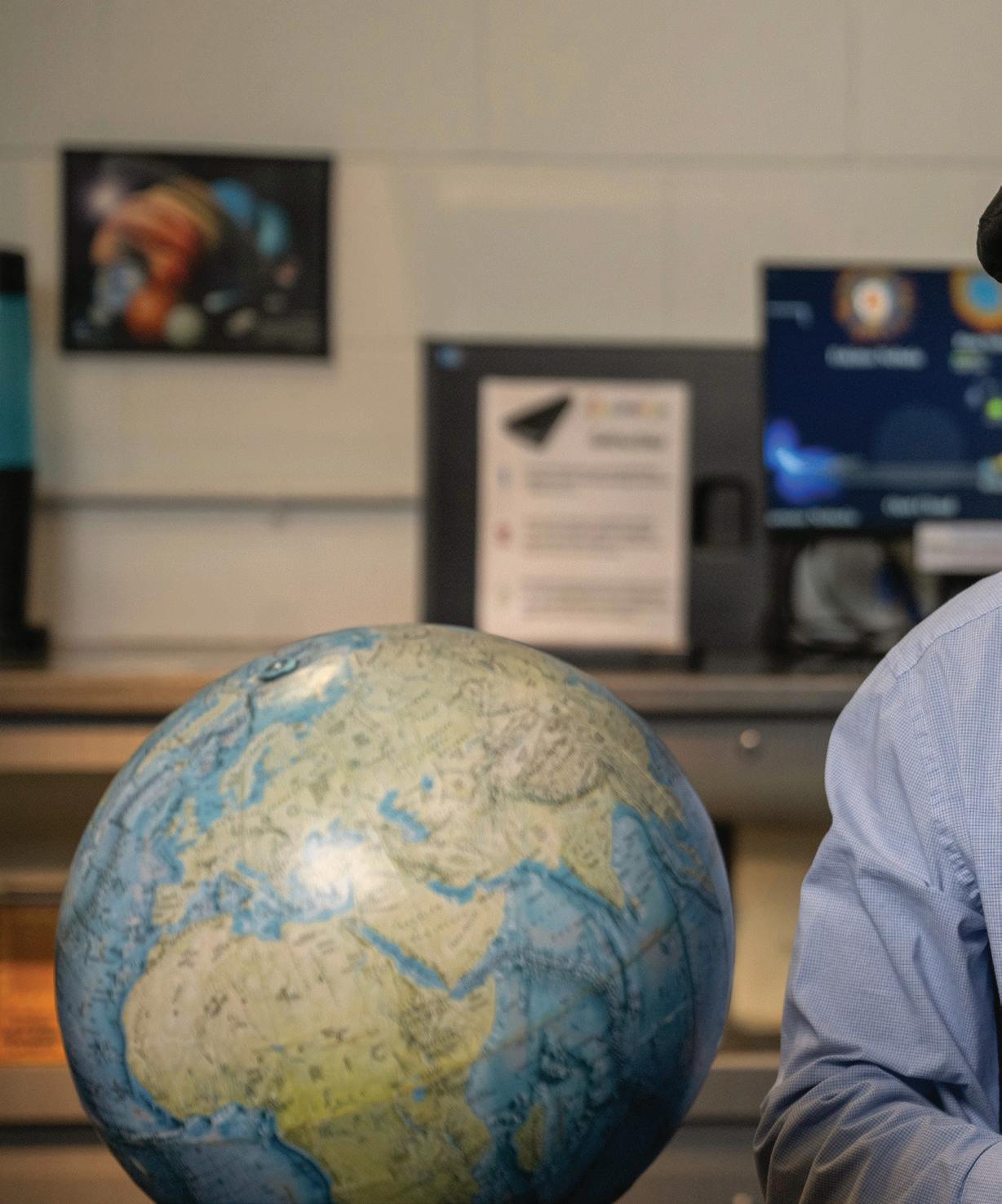

At that point, Williams said, the tidal evolution likely reversed, and the moon began to gradually drift away.
Every year, he said, the moon moves three centimeters farther from Earth. At its current distance from Earth—239,000 miles—the moon now feels a significant tug from the sun’s gravity.
“The moon is now so far away that both the sun and Earth are competing for its attention,” Williams said. “Both are pulling on it.”
His calculations show that, mathematically, a binary-exchange captured satellite could behave as Earth’s moon does. But he’s not certain that’s how the moon came to be.
“No one knows for sure how the moon was formed,” he said. “For the last four decades, we have had one possibility for how it got there. Now, we have two. This opens a treasure trove of new questions and opportunities for further study.”
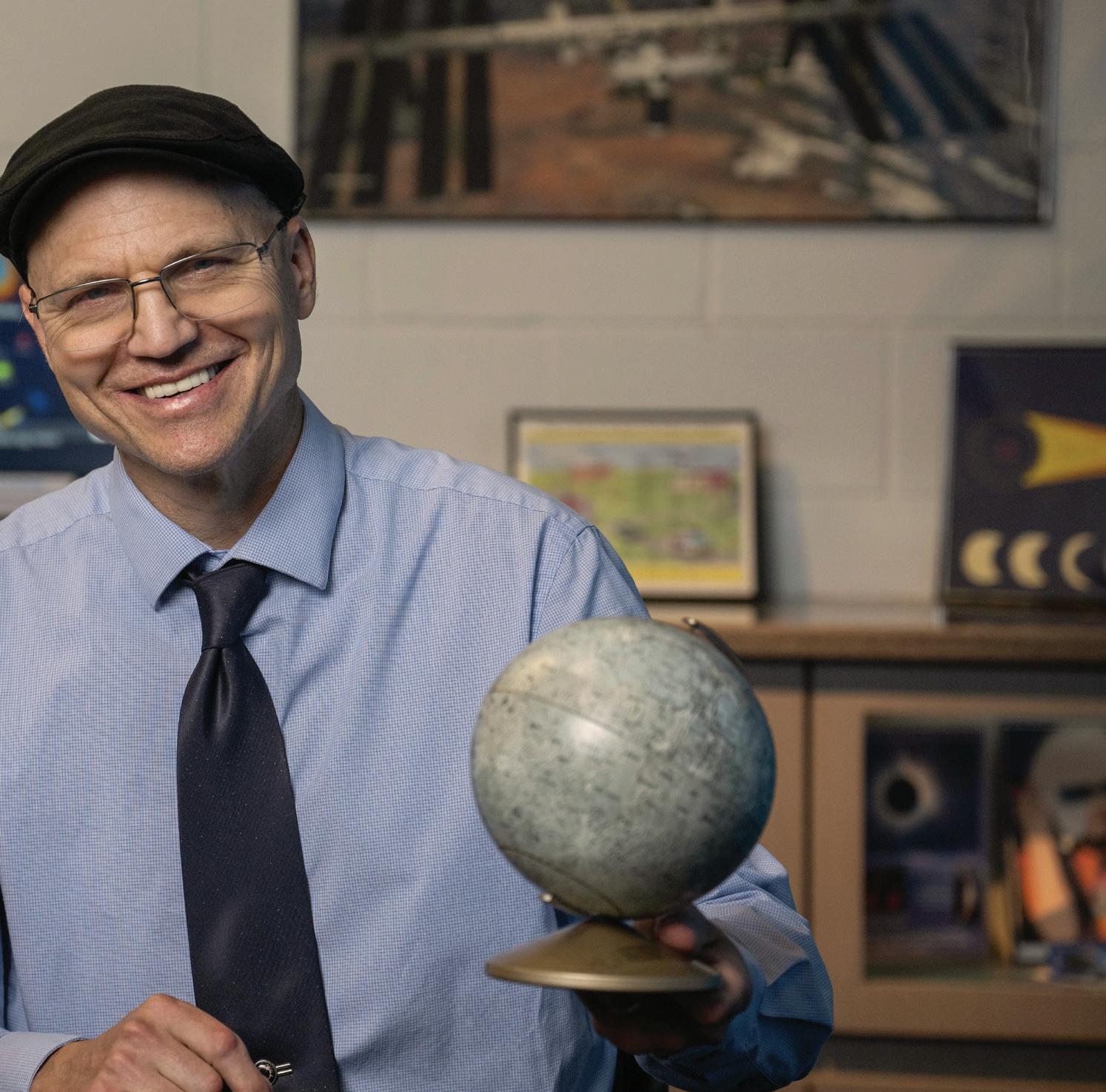

The 2024 total solar eclipse was science at 2,400 mph. As the moon’s shadow swept across Erie, which experienced nearly four minutes of totality the moon completely obscuring the sun’s light a large crowd at the Behrend soccer complex began to cheer.
“In that moment, everyone was an astronomer,” said Dr. Darren Williams, professor of astronomy and astrophysics.
We asked Williams and Jim Gavio, director of the Yahn Planetarium, what they hoped people would take from this once-in-a-lifetime celestial experience:
Williams: “My hope is that, as we shared that experience, people rediscovered some of the childlike curiosity and wonder for things we haven’t seen before, or don’t fully understand. That’s how you begin to appreciate the process of science.”
Gavio: “Many of the children who experienced that moment will remember it for their entire lives. That’s an opportunity: An eclipse makes science fun and accessible and might lead more people to pursue their dreams in astronomy or other types of science.”

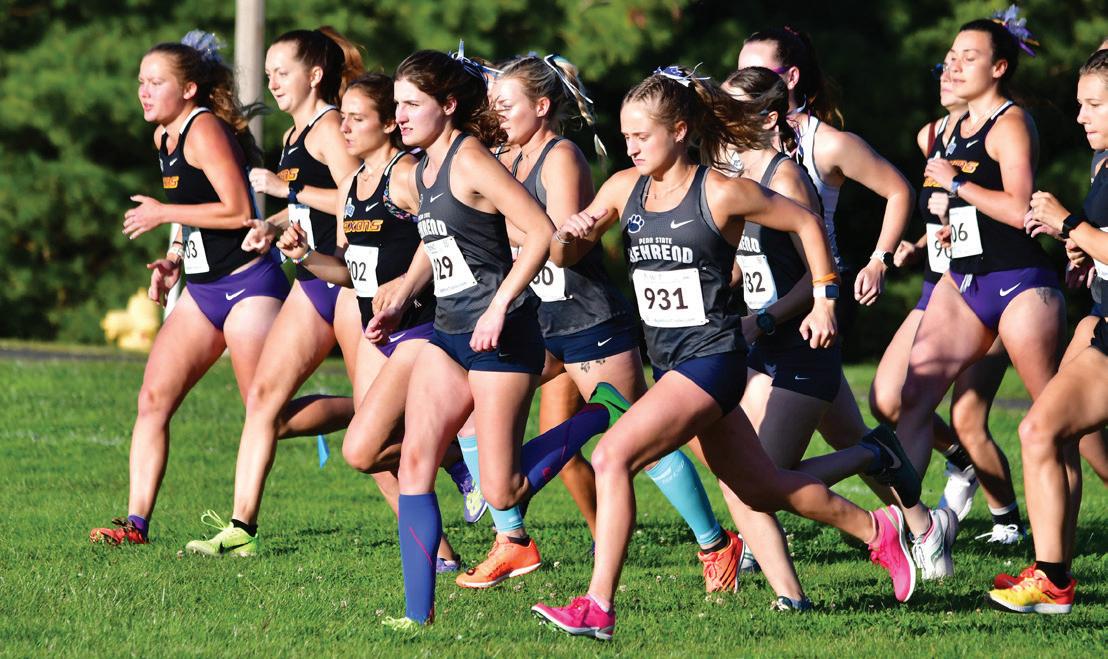

Penn State Behrend won the 2024-25 Allegheny Mountain Collegiate Conference (AMCC) Presidents Cup, with its teams bringing home nine conference championships this year.
The women’s tennis team finished with a 10-2 record and a 4-1 conference record, winning its fifteenth overall title and the first since 2020. Six players were All-Conference selections.
The women’s soccer team ended the season with an 18-3 overall record and regionally ranked as high as No. 22. The Lions captured their seventeenth overall and second straight AMCC Championship. Trinity Prestash, who broke program records for career goals (70) and goals in a season (27), was named AMCC Offensive Player of the Year. Ten players were All-Conference selections.
The men’s soccer team won an eleventh conference title and the first since 2019, concluding the season with a 10-7-4 overall record. Eight players were All-Conference selections.
The women’s cross country team secured a sixth straight and fourteenth overall conference championship. Lindsey Hartle
earned AMCC Individual Runner-Up honors with a time of 25:59.8. Baylee Dernar was named AMCC Newcomer of the Year. Six athletes were All-Conference selections.
The men’s cross country team notched a fifth straight and sixteenth overall AMCC title. Lucas Boyd was crowned AMCC Champion with a top time of 27:40.5. Six runners were AllConference selections.
The men’s swimming and diving team won a seventeenth overall and second straight AMCC title. Anthony Tumino was named AMCC Swimmer of the Year, and Isaac Stoeckle was named Newcomer of the Year. Additionally, ten swimmers were All-Conference selections.
The women’s swimming and diving team won a fourteenth and second straight AMCC title. Camryn Watters was named AMCC Swimmer of the Year, while first-year student Kallie Smith earned Newcomer of the Year honors. Eleven swimmers were All-Conference selections.
The men’s tennis team won its fourth straight and tenth overall AMCC Championship. First-year student Graham Louis earned
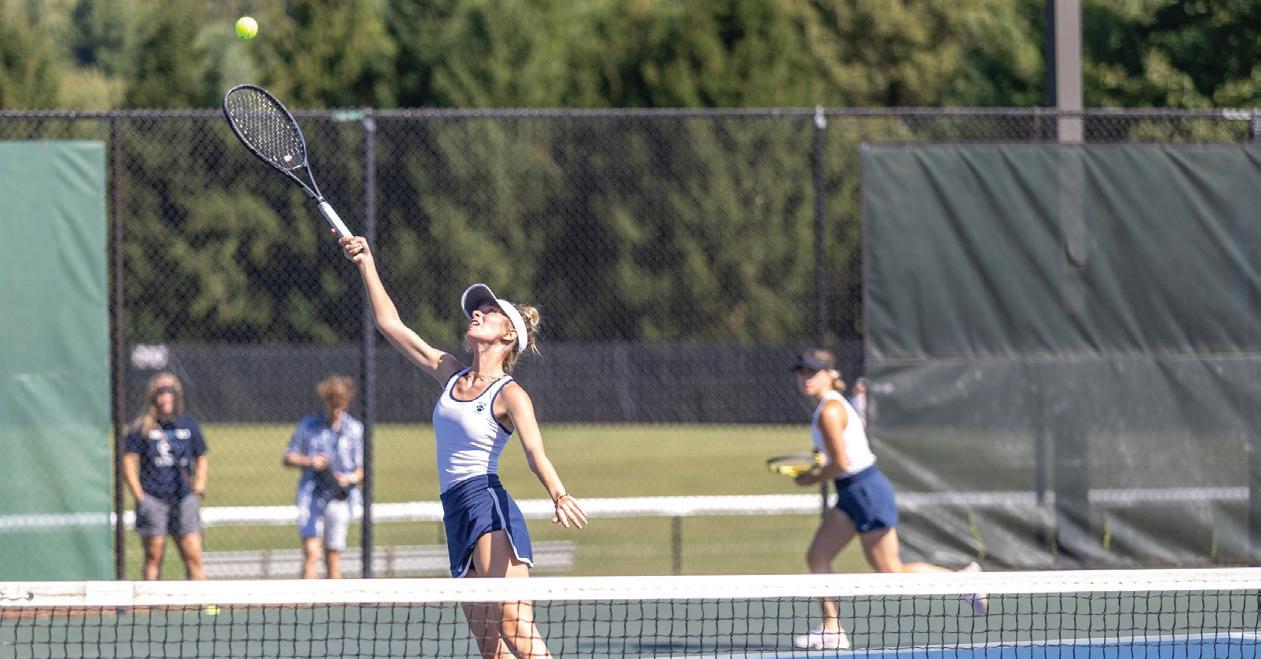
AMCC Newcomer of the Year, while head coach Louis Murphy notched his first Coach of the Year honor. Six players were All-Conference selections
The men’s baseball team won its second straight and eighth overall AMCC Championship, besting Alfred State, 8-2. The team had eleven players selected to the All-Conference team.
The men’s water polo team had a historic 2024 season, finishing with a new program record for single-season wins, with eight, and advancing to its first-ever Mountain Pacific Sports Federation East Championship. First-year student Nick Thompson was named Newcomer of the Year, the first conference award in program history. Four players were All-Conference selections.
The women’s water polo team dropped its final contest of the season on the last day of the Collegiate Water Polo Association (CWPA) Division III Championships, finishing sixth at conference championships, a first in program history. Makenzie Rickerd was named to the CWPA All-Tournament Second Team. Darragh Martin earned CWPA All-Conference Second Team honors. Both were also named ACWPC (American Collegiate Water Polo Coaches Association) All-America Honorable Mention.
10 Newcomers of the Year 1 Runner of the Year 1 Wrestler of the Year 2 Swimmers of the Year STORY CONTINUED ON NEXT PAGE ⊲
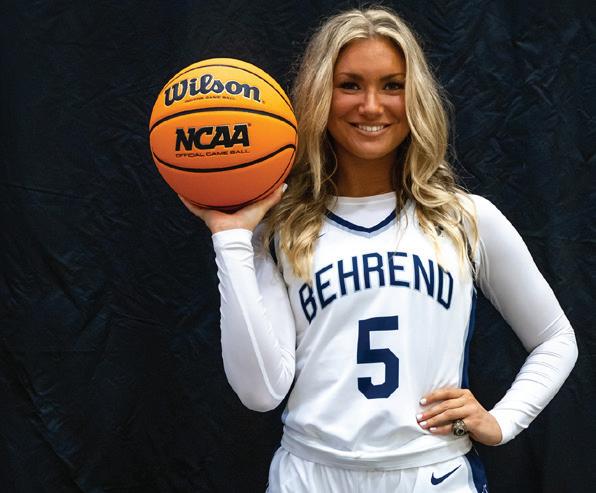
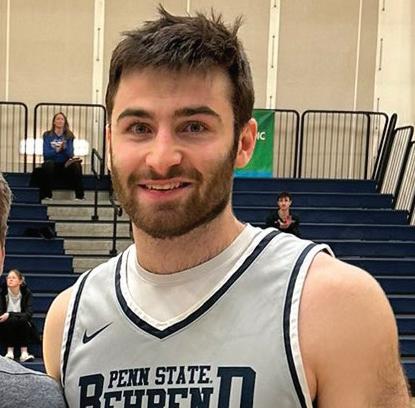
The men’s and women’s basketball teams had a momentous season with two players breaking all-time leading scorer records.
Senior RACHEL MAJEWSKI broke a twenty-threeyear-old program record, finishing her collegiate career with 1,750 points.
On the men’s side, TOMMY DIRIENZO broke a twelve-year-old record, ending his collegiate career with 1,836 points.
PLAYERS OF THE YEAR: Lucas Boyd (men’s cross country), Nicole Croushore, (women’s soccer – defensive), Nolan Fenton (wrestling), Rachel Majewski (women’s basketball), Jocelyn McNany (softball), Trinity Prestash (women’s soccer –offensive), Anthony Tumino (men’s swimming), and Camryn Watters (women’s swimming).
NEWCOMERS OF THE YEAR: Rudy Brown (wrestling), Baylee Dernar (women’s cross country), Alaina Fabin (women’s basketball), Lillie Holt (women’s bowling), Cadence Jones (women’s volleyball), Graham Louis (men’s tennis), Kallie Smith (swimming), Isaac Stoeckle (men’s swimming), Nick Thompson (men’s water polo), and Carter Tobin (outdoor track and field).
COACHES OF THE YEAR: Greg Cooper (men’s and women’s cross country), Caleb Garvey (wrestling), Gina-Bella Mata’afa (men’s water polo), Louis Murphy (men’s tennis), Patrick O’Driscoll (women’s soccer), Christine VanHook (women’s basketball), and Paul Benim (baseball).

The women’s volleyball team completed the season with a 13-18 overall record, falling to Penn State Altoona in the AMCC semifinals. Cadence Jones was named AMCC Newcomer of the Year. Two players were All-Conference selections.
The men’s volleyball team finished its season 13-16 overall, losing to the No. 1 Buffalo State Bengals in the AMCC Championship. Three players were All-Conference selections.
The men’s golf team placed sixth in the AMCC tournament. Owen Blum tied for fifteenth place with a team-low score of 165 over the two-day competition.
The wrestling team finished its season with a 9-7 record and a second-place finish at the AMCC Championship. Five wrestlers were All-Conference selections.
The men’s basketball team finished the regular season on a three-game winning streak to claim the fourth seed in the conference tournament, where the Lions lost to La Roche. Two players were All-Conference selections.
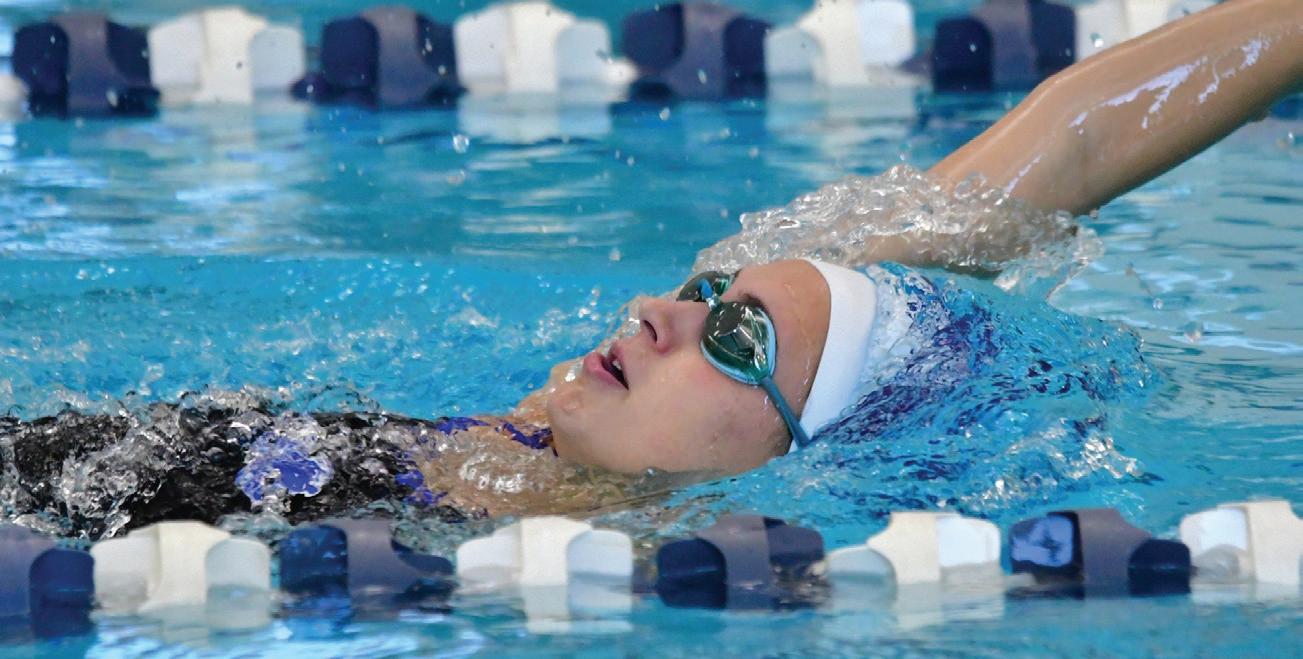
The women’s basketball team registered its first undefeated season in the AMCC Regular-Season Championships, finishing conference play with a 16-0 record. Rachel Majewski was named AMCC Player of the Year. Three players were All-Conference selections.
The men’s and women’s indoor track and field teams placed fourth and sixth, respectively, while the outdoor track and field teams finished second and fourth, respectively, at the SUNYAC Championships. The women’s teams (indoor and outdoor) had three All-Conference selections, while the men had eighteen total. Dan Dabrowski became a four-time All-American in the discus with a fifth-place finish at the NCAA Championships.
The women’s bowling team finished its season with a 34-60 record, falling in the first round of the conference tournament. Lillie Holt was named AMCC Newcomer of the Year. Dee Dee Elijah was named to the All-Tournament team.
The women’s softball team tallied a 17-22 overall record, falling in the AMCC Championship Tournament. The Lions had five players named All-Conference and senior Jocelyn McNany was named the Player of the Year.
Nine former student-athletes were inducted into the Penn State Behrend Athletics Hall of Fame this past fall. The 2024 inductees were: Catie Bertges ’14, cross country/track and field; Dante DeSantis ’14, baseball; Chelsea Magnusen ’14, volleyball; Rachel (Mueller) Palcic ’14, soccer; Kate (Spade) Flynn ’14, cross
country/track and field; MaryEllen (Spooner) Cottle ’13, swimming/ water polo; Sam Vasy ’14, soccer; Eric Vunovic ’14, soccer; and Chad Zurat ’14, baseball. Five AMCC Championship teams were also honored on their twenty-fifth anniversaries: women’s basketball, women’s soccer, men’s soccer, softball, and women’s tennis.
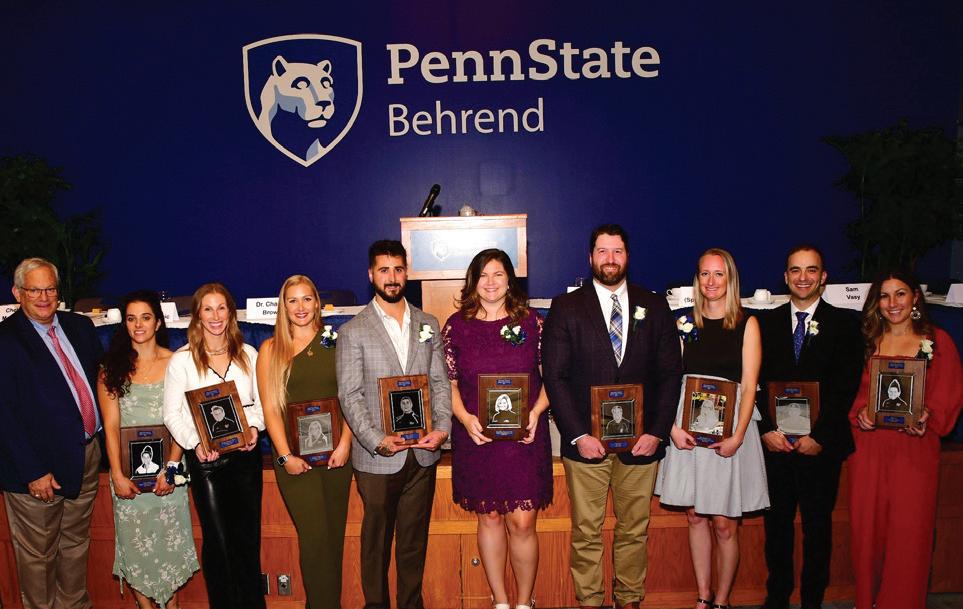


HONORED FOR SERVICE: Tyler Stickles, who graduated in May with degrees in Environmental Science and Biology, was the recipient of the 2025 Ralph Dorn Hetzel Memorial Award. The award, named for Penn State’s tenth president, recognizes a student who balances high scholastic achievement and leadership in student and community activities.
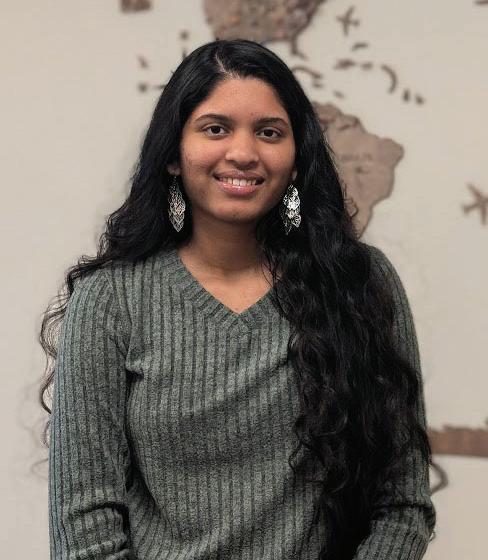

TOLERANCE AWARD WINNER: Sean Martin, a senior Digital Media, Arts, and Technology major and president of the Digital Creations Club, was the recipient of the 2025 Jackson Lethbridge Tolerance Award, which recognizes a Penn State student whose work enhances the understanding of diverse cultures. He spearheaded the development of a semester-long International Film Festival.

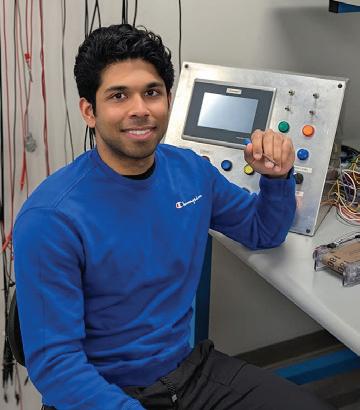
FREEZING FOR A REASON: In April, the Penn State Behrend community raised more than $10,000 for Pennsylvania Special Olympics by jumping into the chilly waters of the Bear Force One mobile pool in the Reed Union Building parking lot. Even Chancellor Ralph Ford took the plunge, twice. Pictured at left are members of Kappa Sigma fraternity, which raised the most funds for the event: $2,900! Runner up: Alpha Sigma Alpha, which raised $1,237.
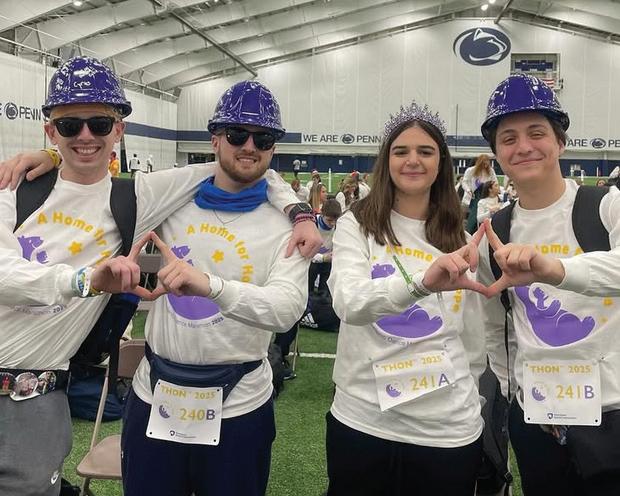
BEHREND AT THON: This year’s THON raised a record $17.7 million. The Behrend Benefiting THON student organization raised more than $74,000—also a record! Behrend’s dancers were, from left, Hunter Kozlowski, Johnathan Marks, Ariana Quam, and Daniel McMaster, all seniors.
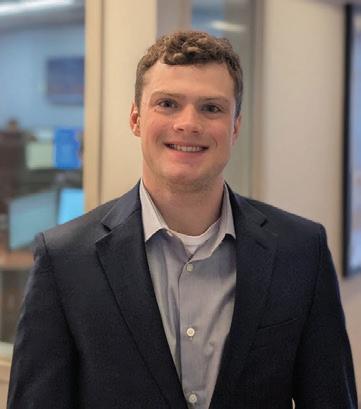
STANDOUT STUDENTS FEATURED ON BLOG: Penn State Behrend’s Class of 2025 is ready to make a difference in the world. More than thirty students were recently featured on the college’s blog. To learn more about a few of our remarkable graduates, who have conducted valuable research, pioneered innovation, overcome challenges, and engaged in life in a big way, visit BehrendBlog.com.

EHSAN HOQUE, a 2004 Computer Engineering graduate, was recognized by former President Joe Biden as one of 400 recipients of the Presidential Early Career Award for Scientists and Engineers. This is the highest recognition by the U.S. Government for scientists and engineers. Hoque is an associate professor of computer science at the University of Rochester, where he codirects the Rochester Human-Computer Interaction (ROC HCI) group. He was recognized for his work advancing human-computer interaction with AI.

KRISTEN (BESSETTI) NIELSEN, a 2016 Communication graduate and an assistant producer at WQLN, Erie’s public broadcasting station, recently won an Emmy from the Central Great Lakes Chapter of the National Academy of Television Arts & Sciences. She was honored for her team’s work on “Chronicles: Bellwether,” a three-part docuseries exploring the political evolution of Erie.
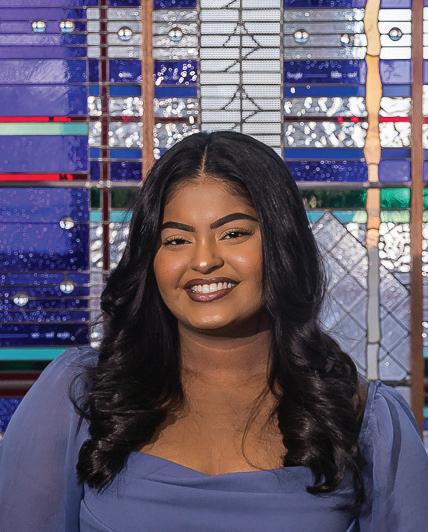
, a 2024 Political Science alumna, is the recipient of the third-annual Mary Behrend Impact Award, which is presented by the Women’s Engagement Council. The award recognizes individuals who have made contributions that support and lift women. Choudhury, who plans to attend law school, is currently a paralegal for an immigration attorney at Khan Law LLC in Detroit. She manages cases involving family-based petitions, asylum, refugee and status adjustments, and other topics. She provides translation services in Bengali, Sylheti, and Spanish.
Last summer, Behrend Pioneer Alumni, who attended Behrend fifty or more years ago, were invited to return to their alma mater for a full day of programming and activities, including tours of campus and Glenhill Farmhouse, an ice cream social, an outdoor picnic, and a summer carillon bell concert. Behrend was happy to welcome more than thirty alumni who marveled at the expansion of their once-small campus.


“What do you like best about Behrend?”
“M
y favorite thing about Behrend is what I call the ‘Goldilocks principle.’ The Penn State community spans the world, and we have access to resources across all of the Commonwealth Campuses. Here at Behrend, we have 4,400 students on-campus and online, but I often feel that I know one in every five students that I see. We have a welcoming campus that makes me feel like I always have someone to talk to, and I hope other students feel that, too.”
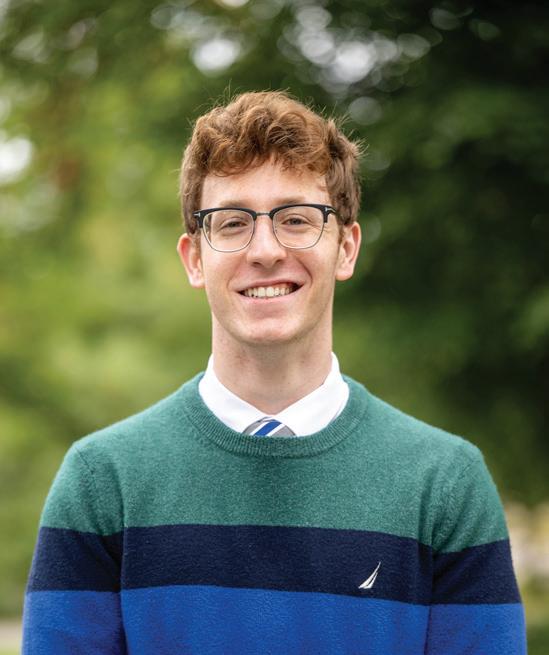
Zane Lewis
— Zane Lewis, rising senior in Finance and Accounting and president of Behrend’s Student Government Association
Youth Education Outreach (YEO) is hitting the road in style thanks to a brand-new van that will expand the team’s ability to deliver hands-on STEAM (Science, Technology, Engineering, Arts, and Math) programming to K-12 students across the region.
The van, made possible through donations from private donors and local companies, expands YEO’s ability to transport supplies and provide programming off-site. Previously, staff were limited to what they could fit into their personal vehicles, often restricting the scale of their activities. The new van removes those constraints, allowing YEO to pack the van with plenty of interactive fun.
“The van allows us to bring Penn State Behrend to youth and meet them where they are,” said Melanie Ford, director of YEO at Behrend. “We’re grateful to the donors who made the purchase of the van possible. This investment in our youth will have a lasting impact on our community.”
